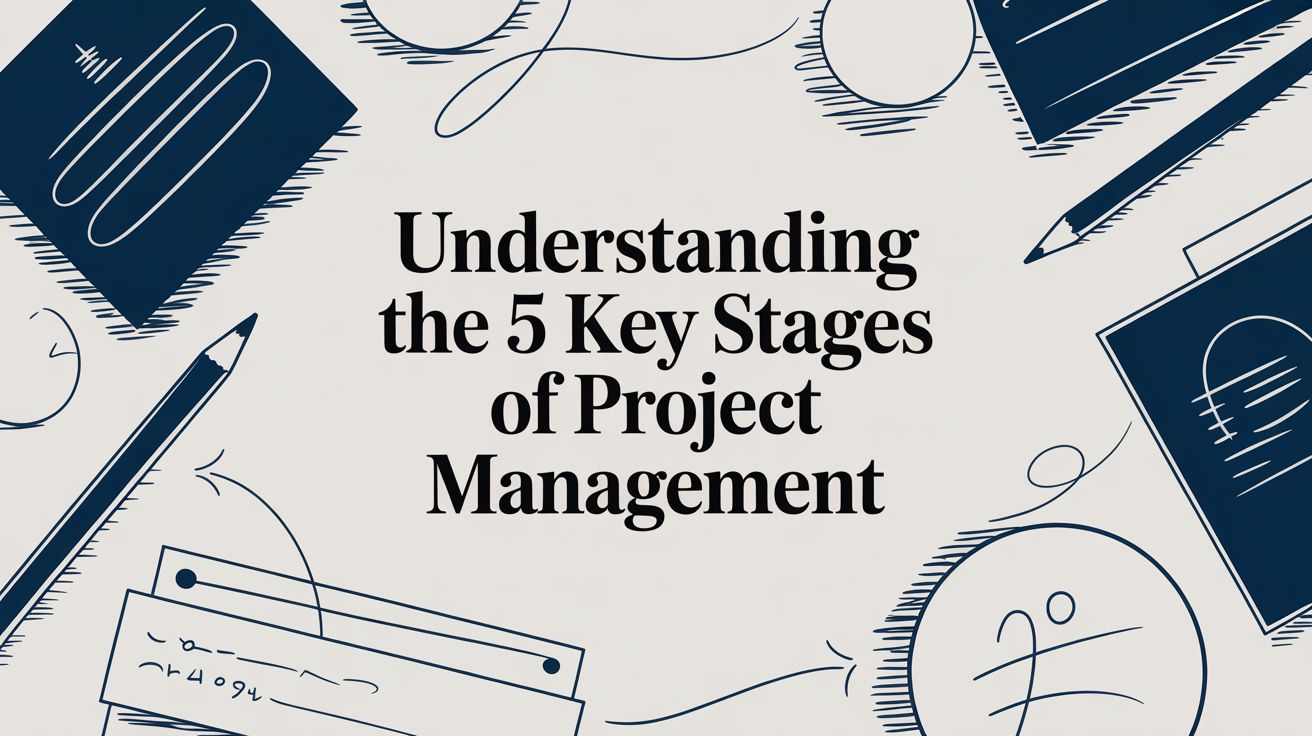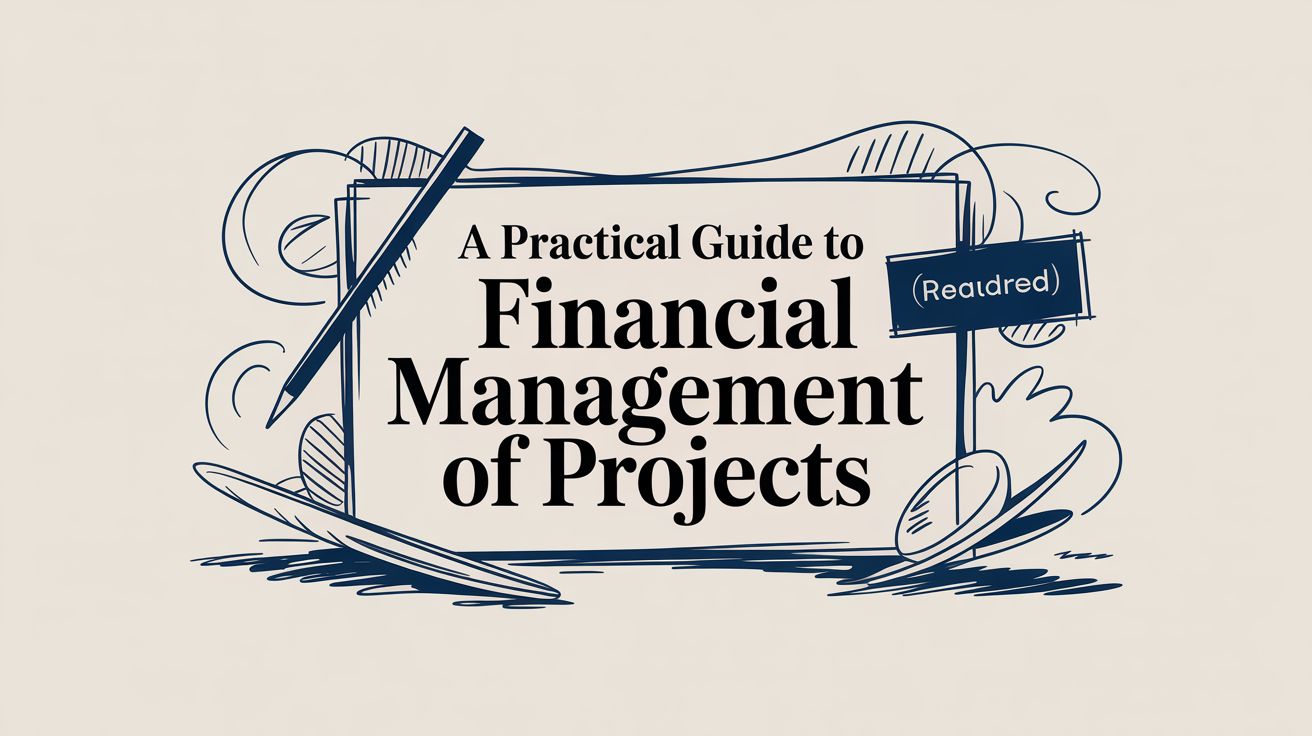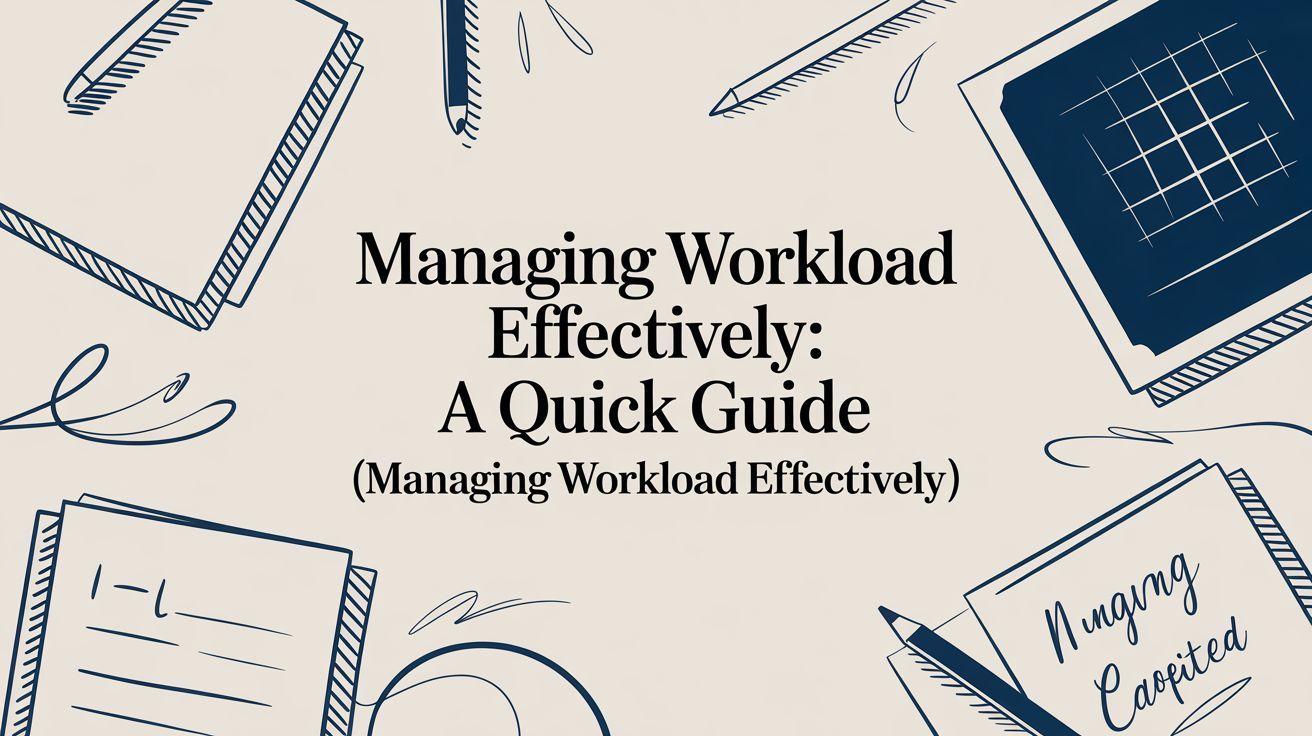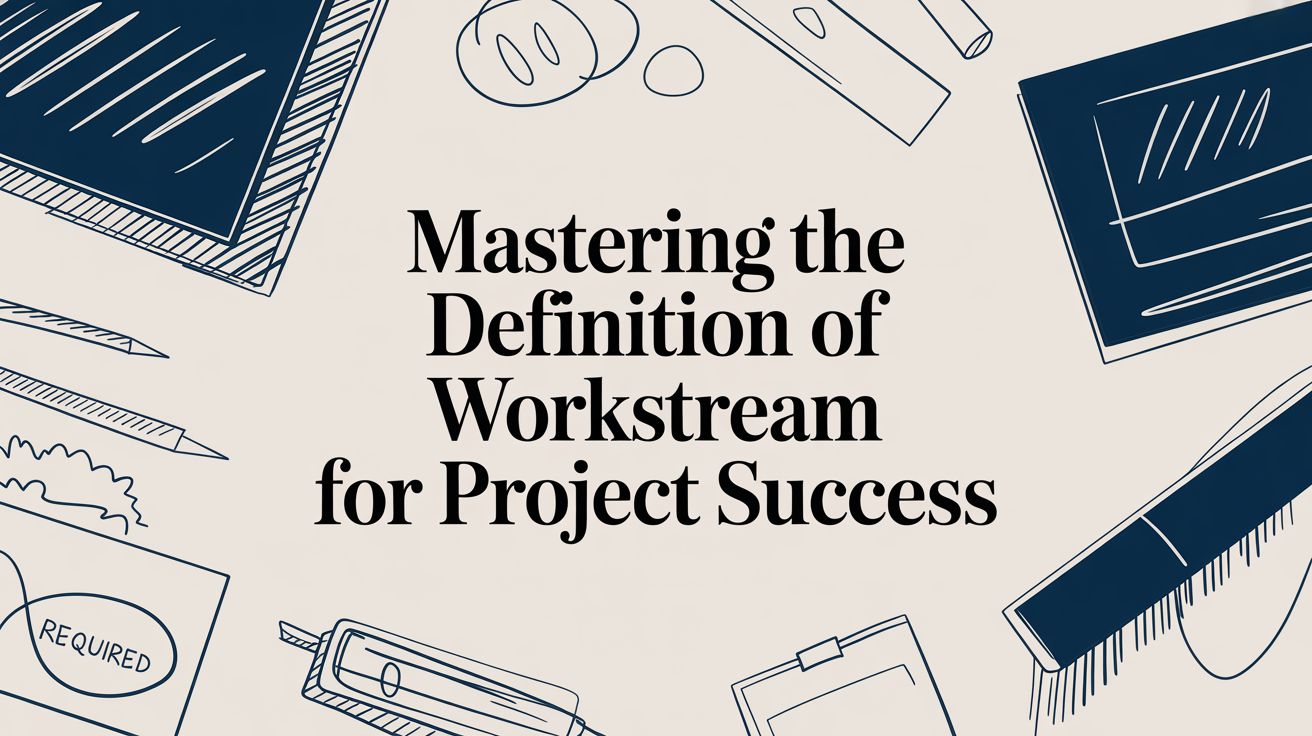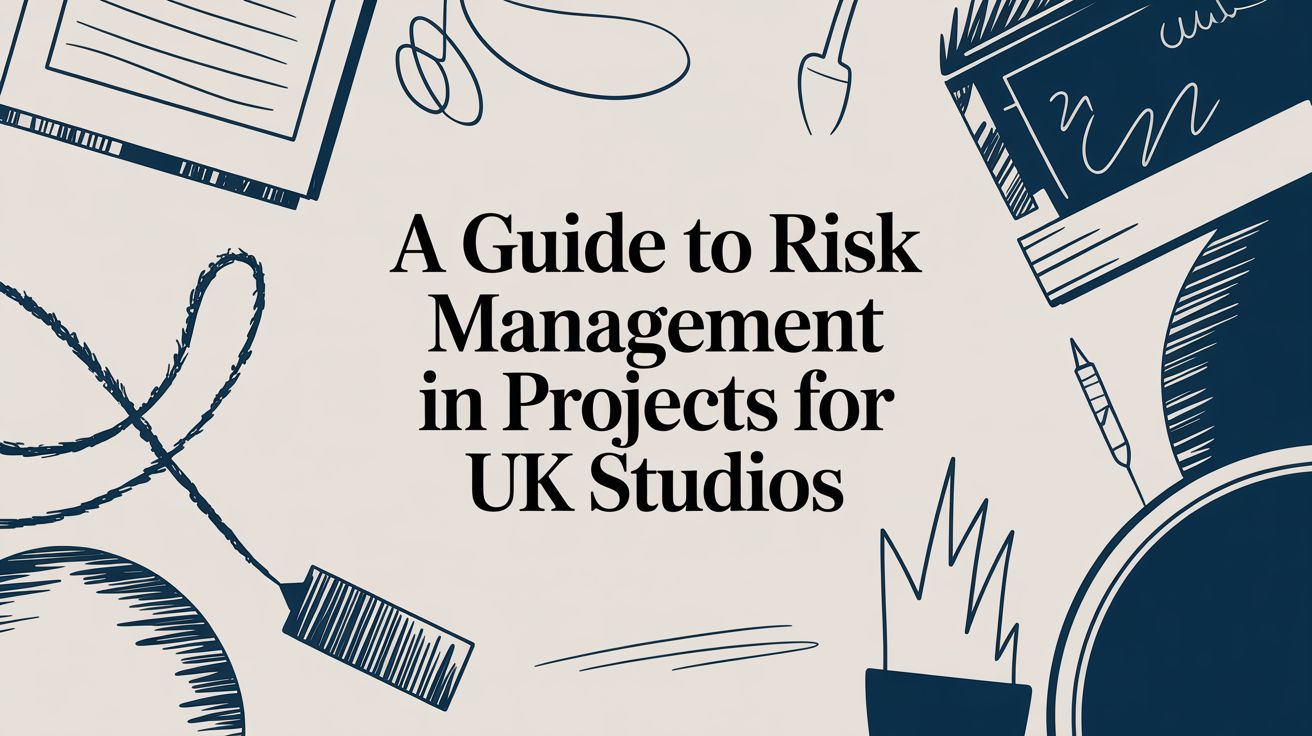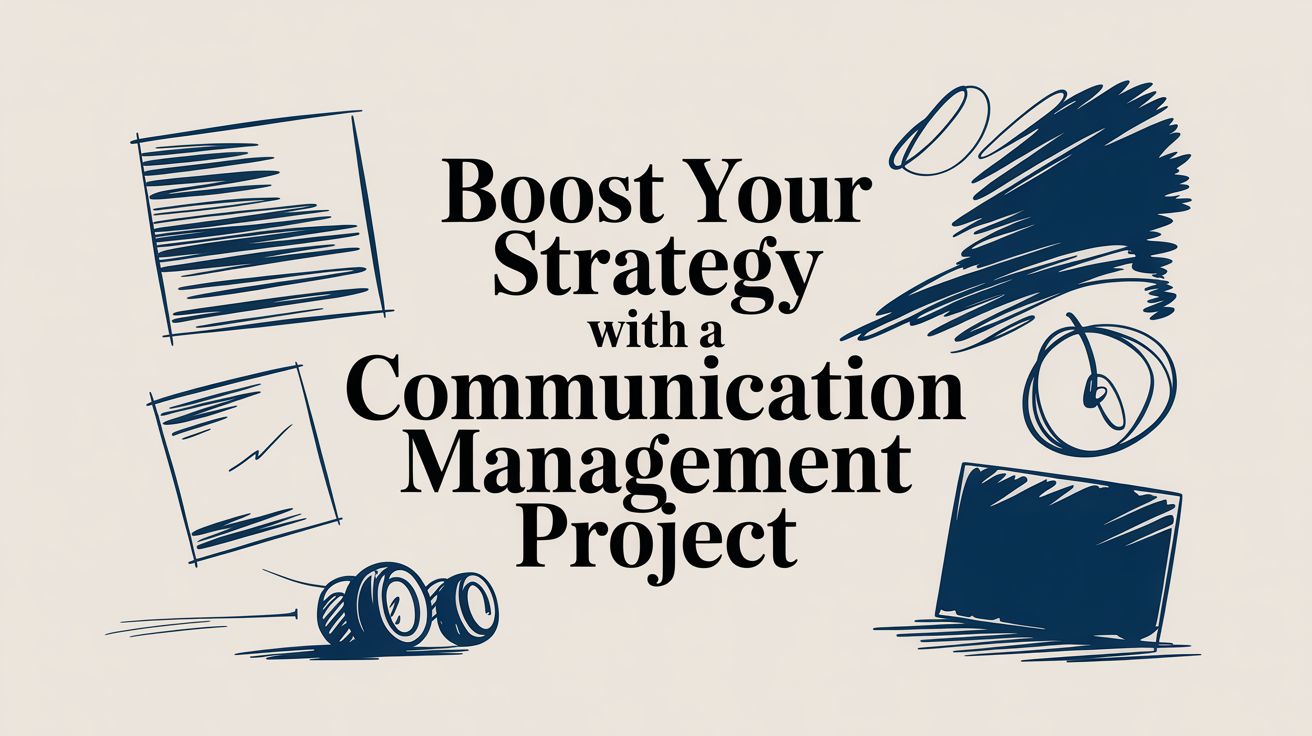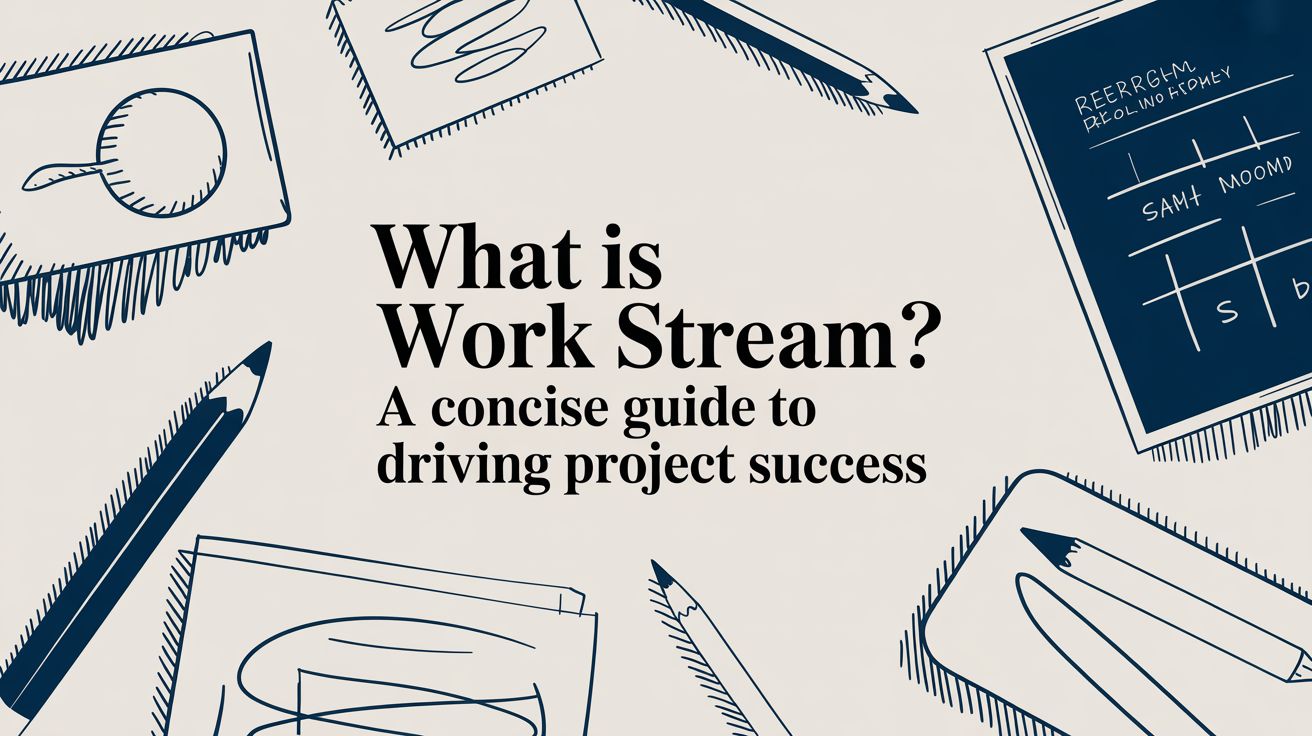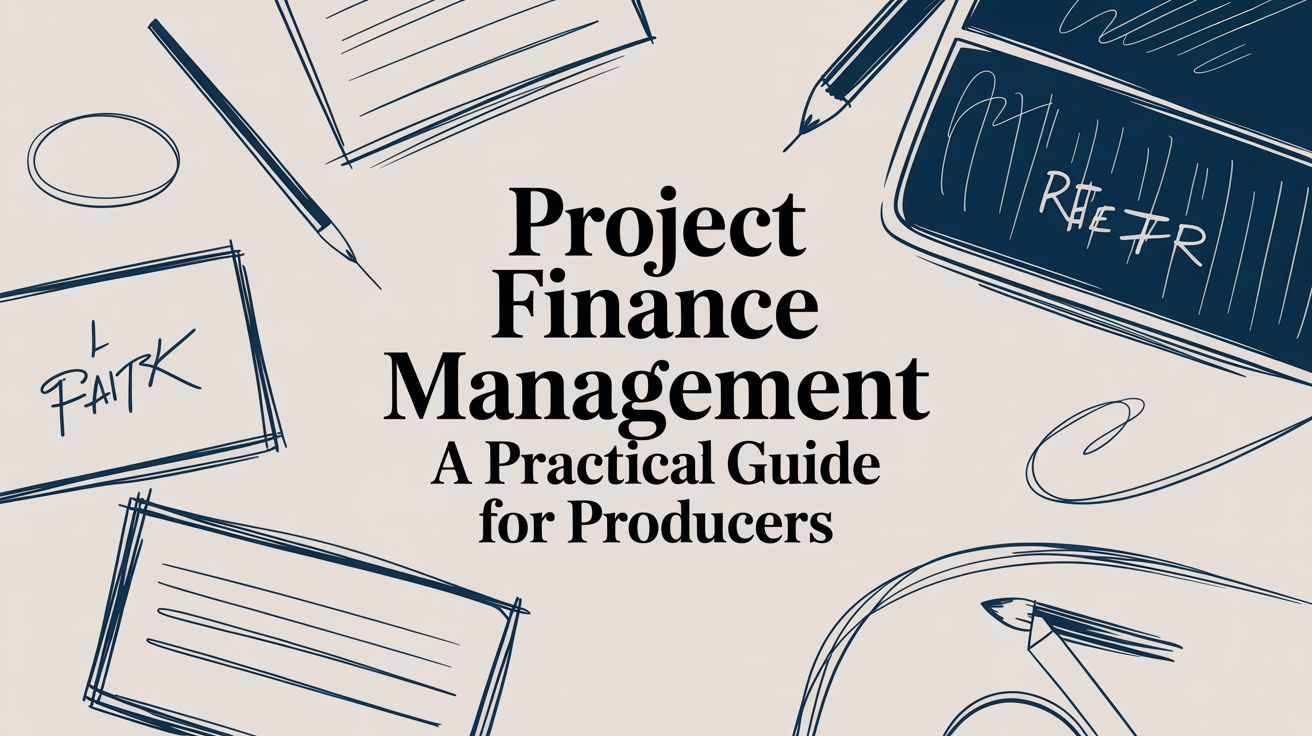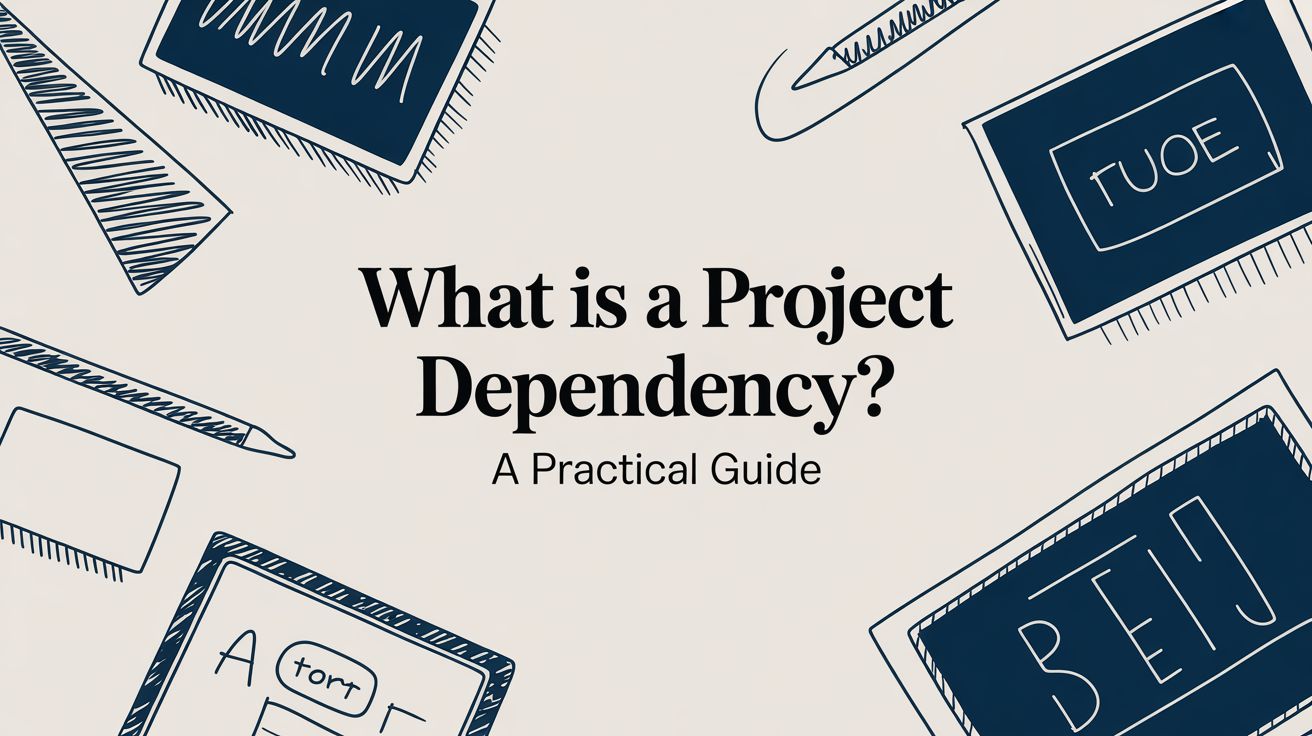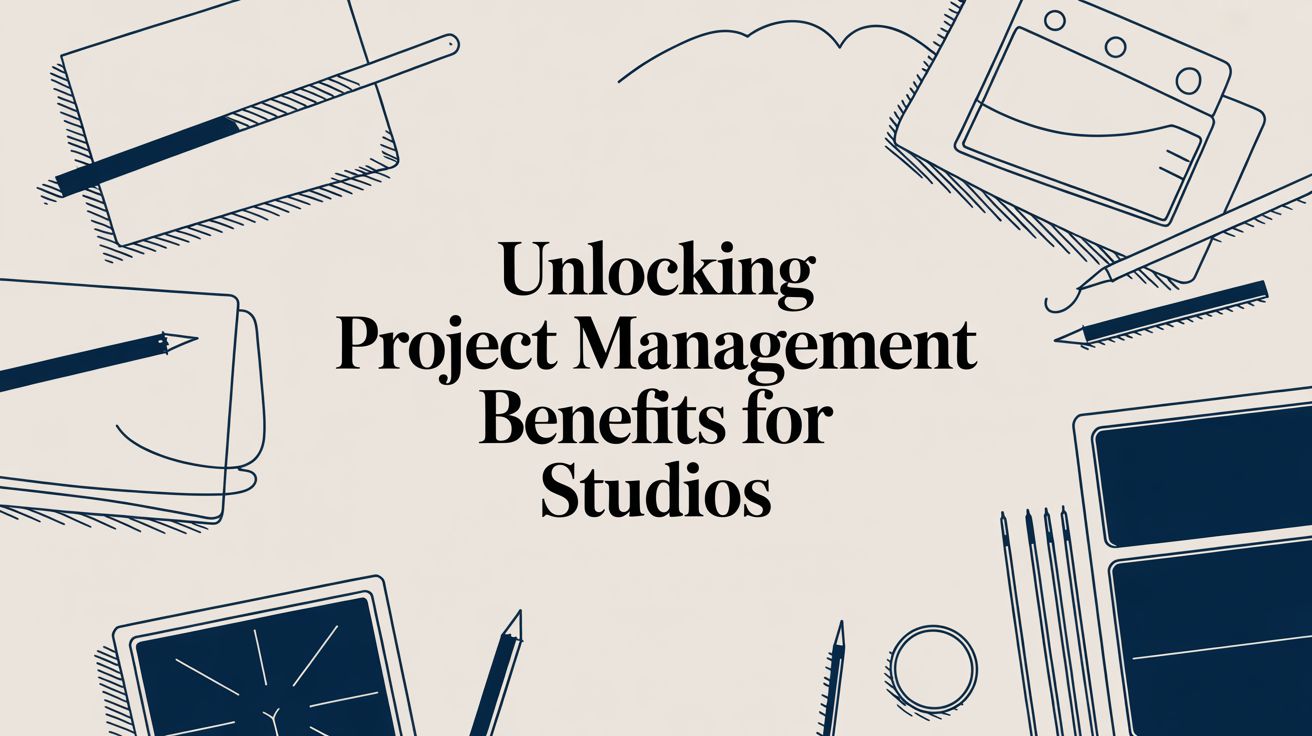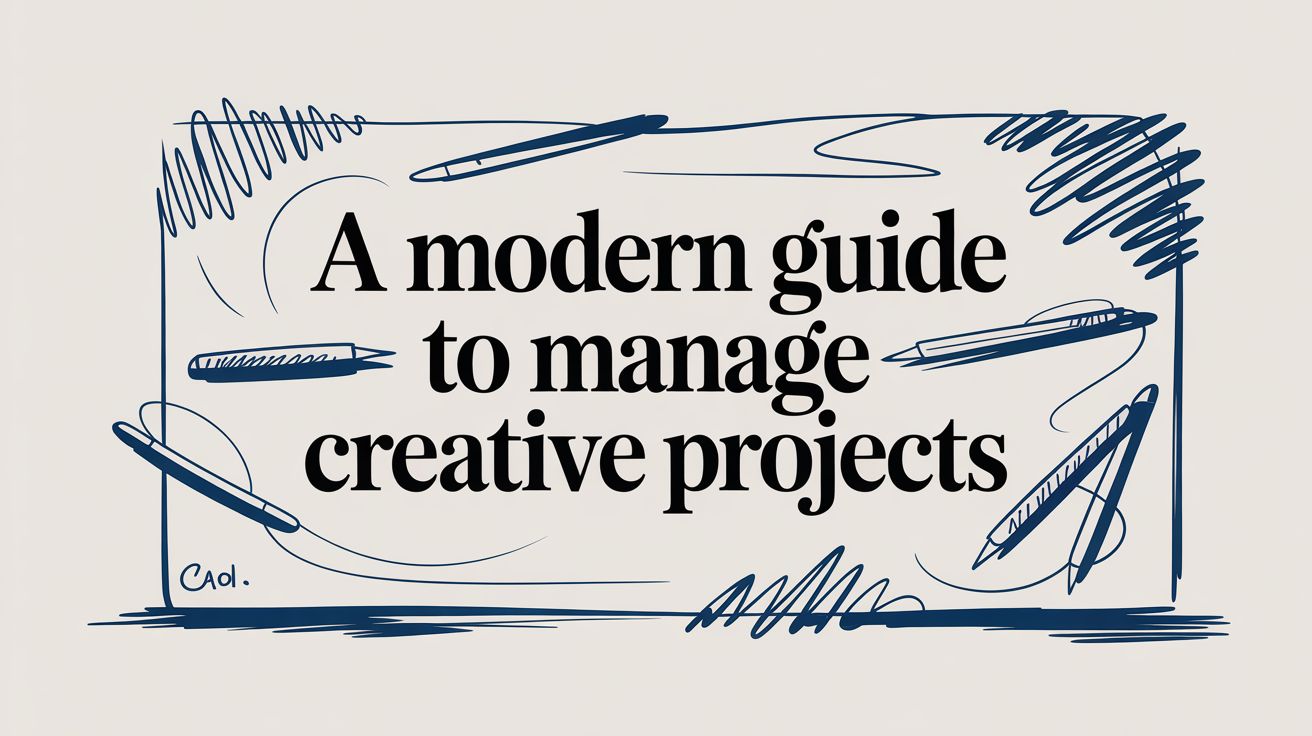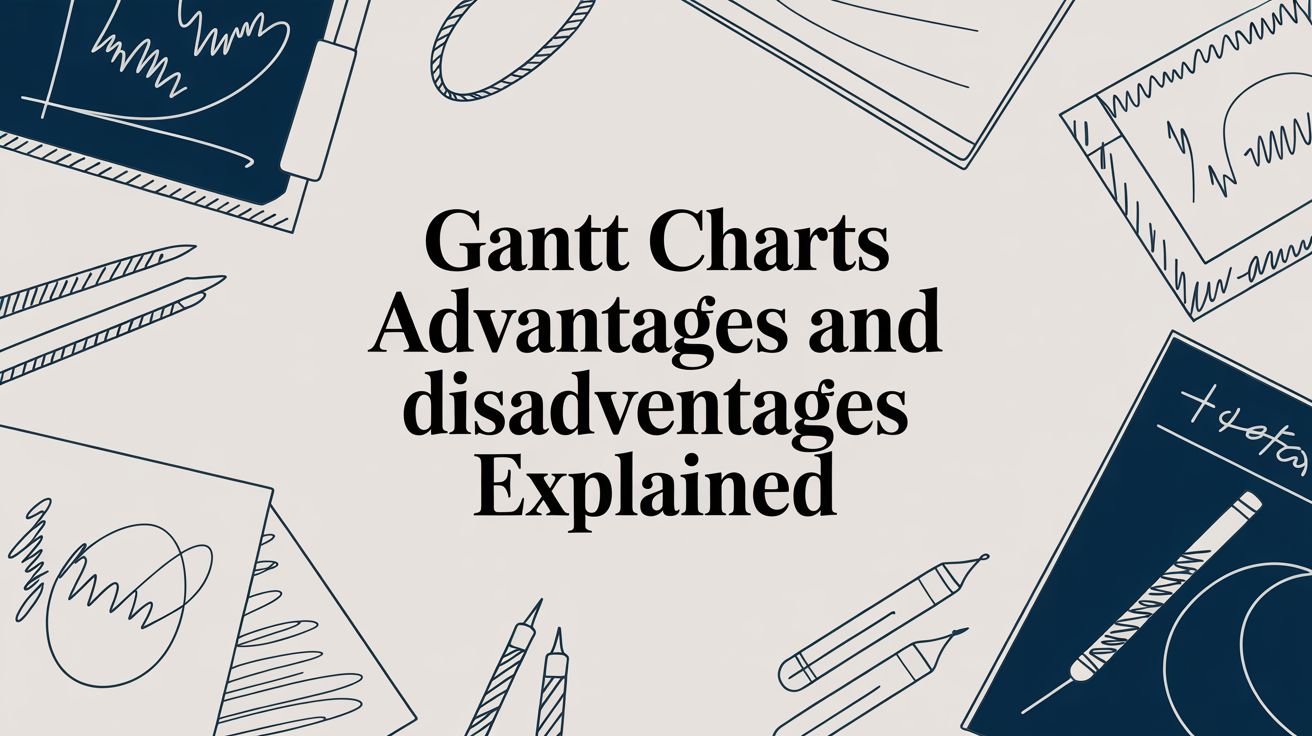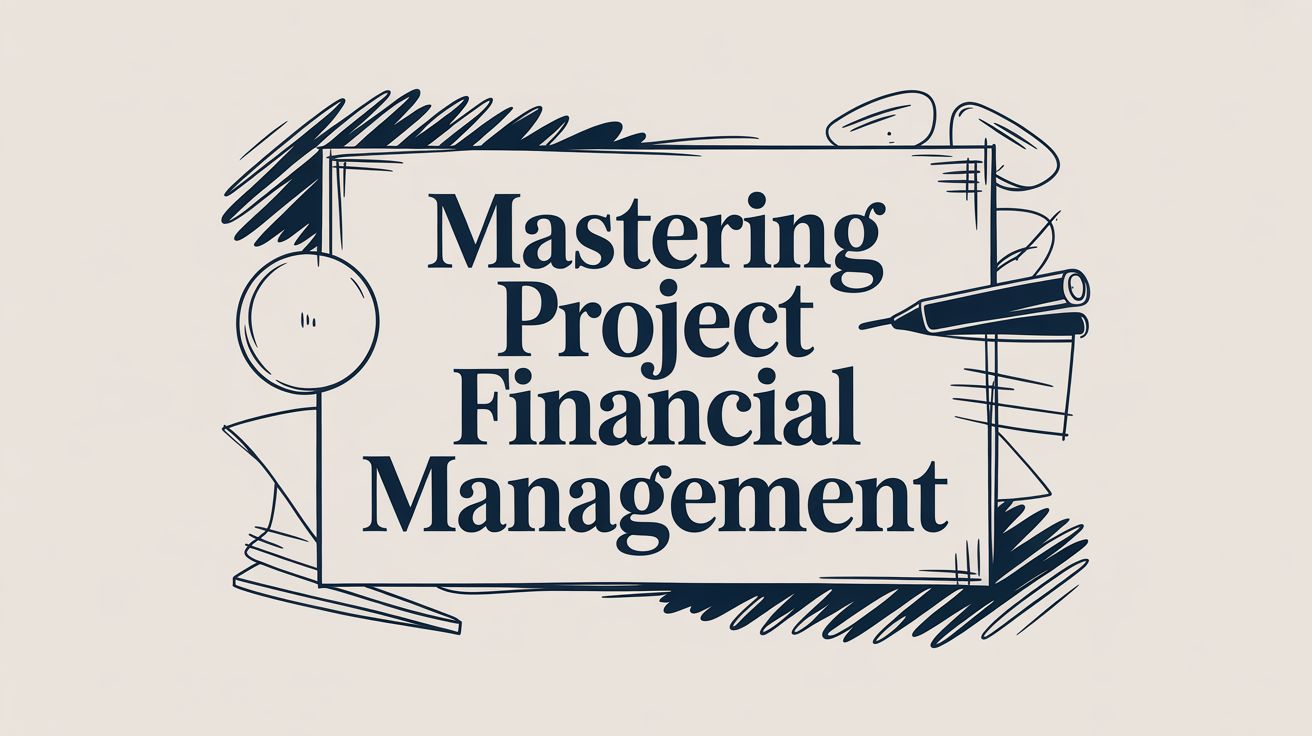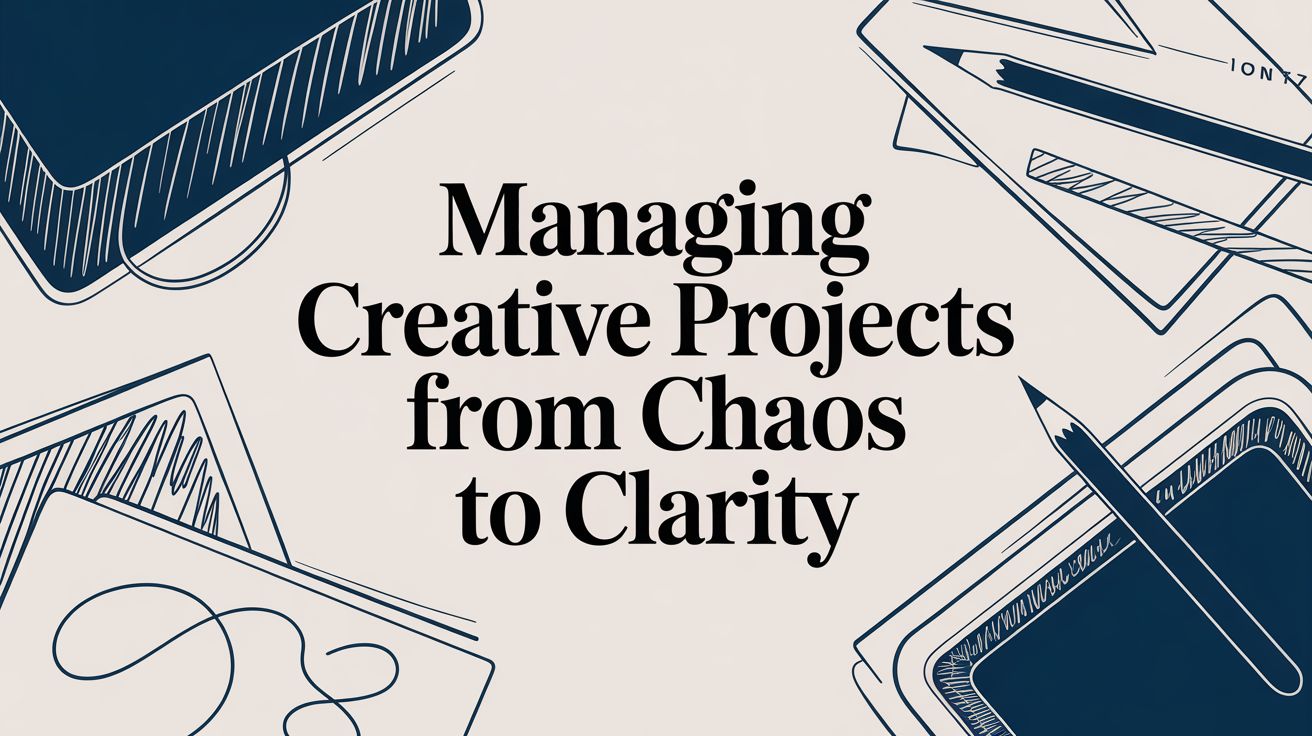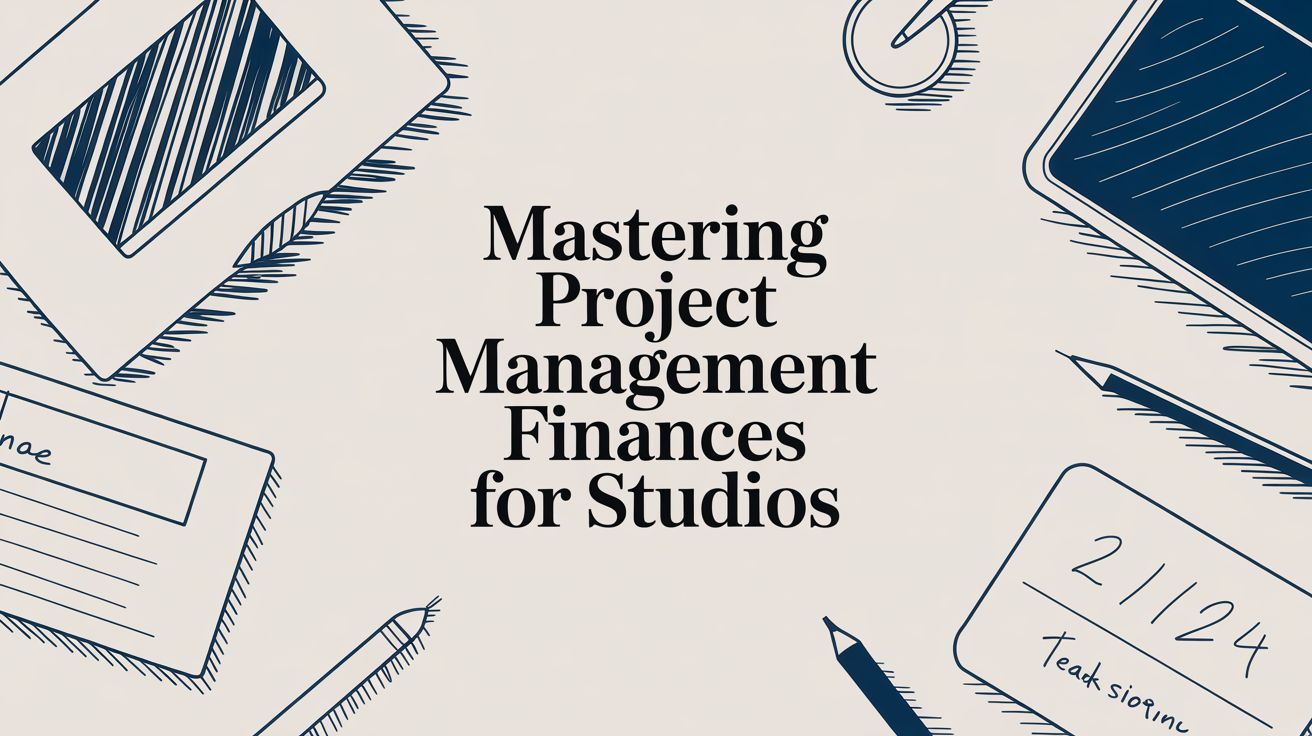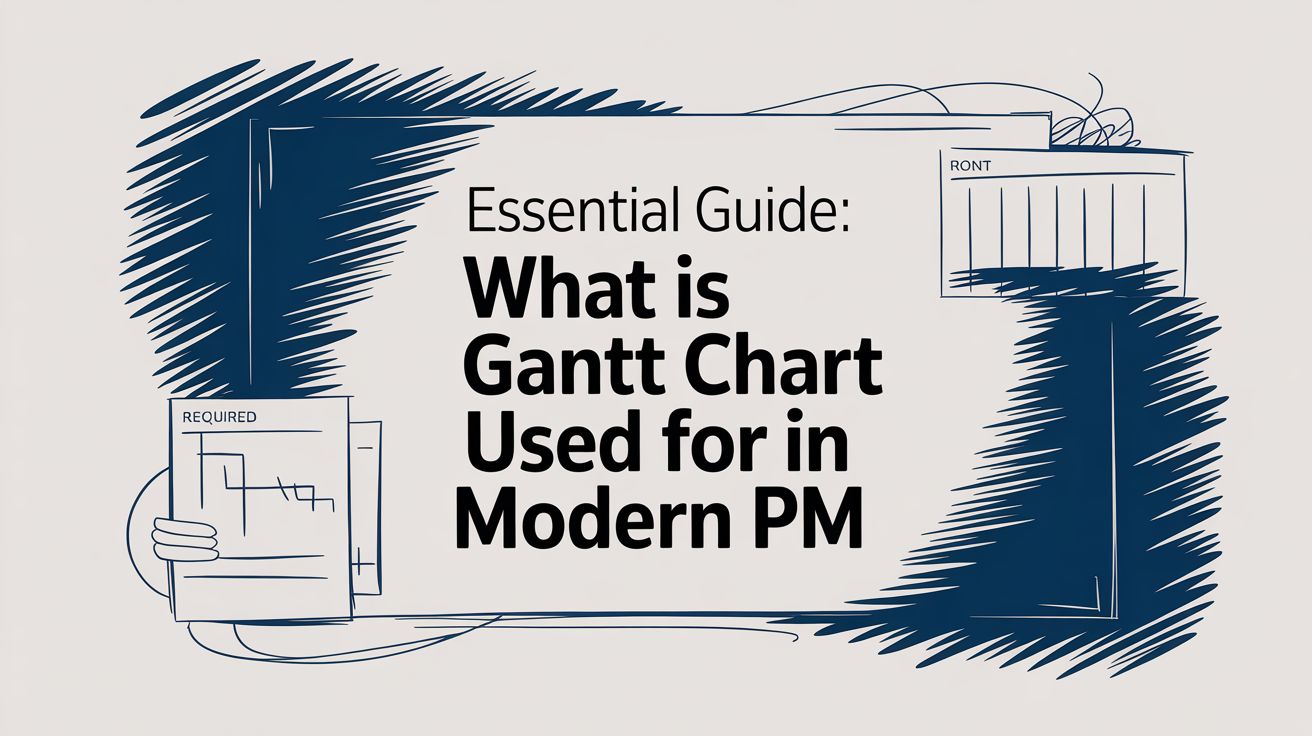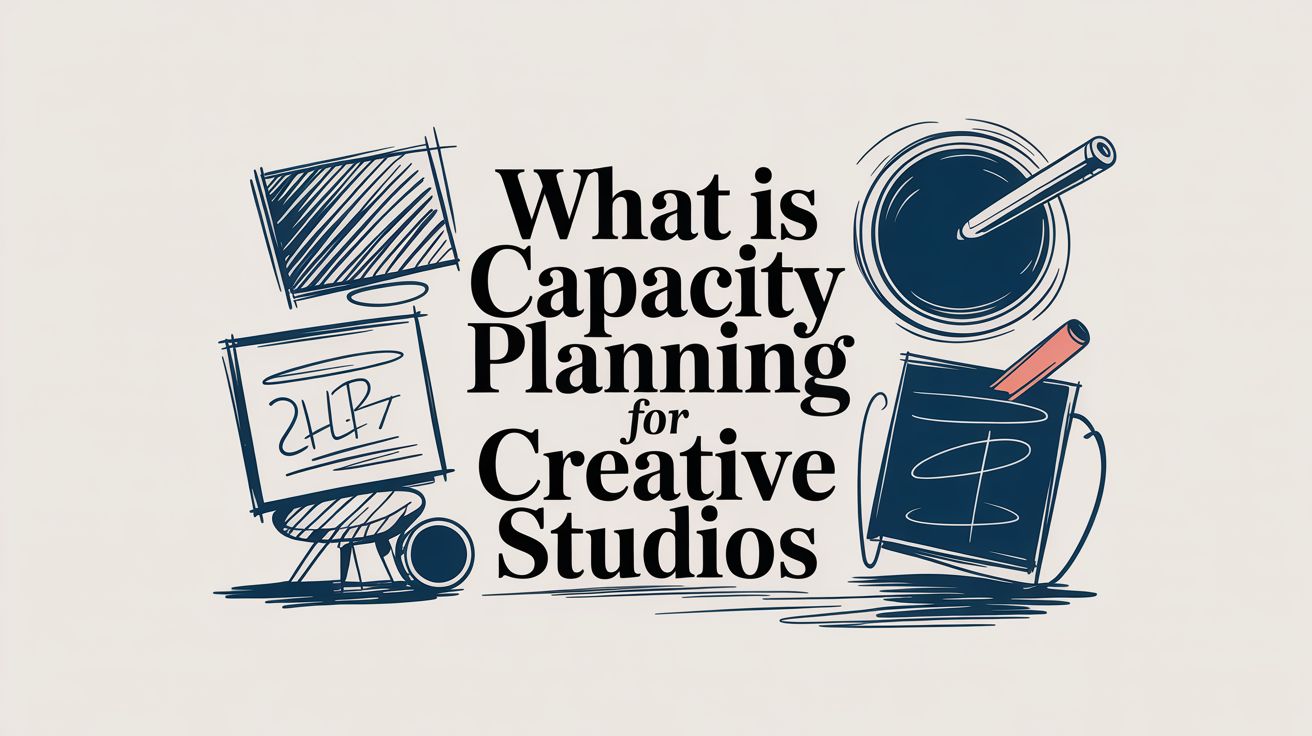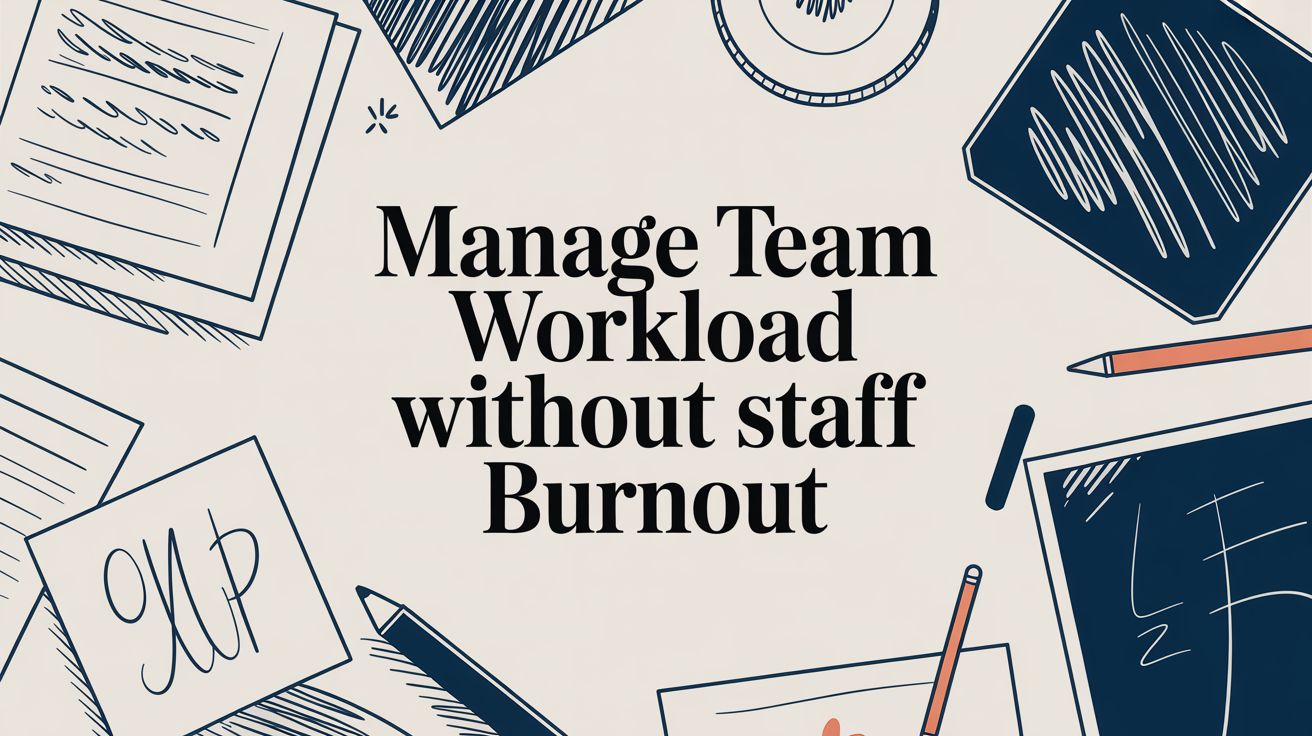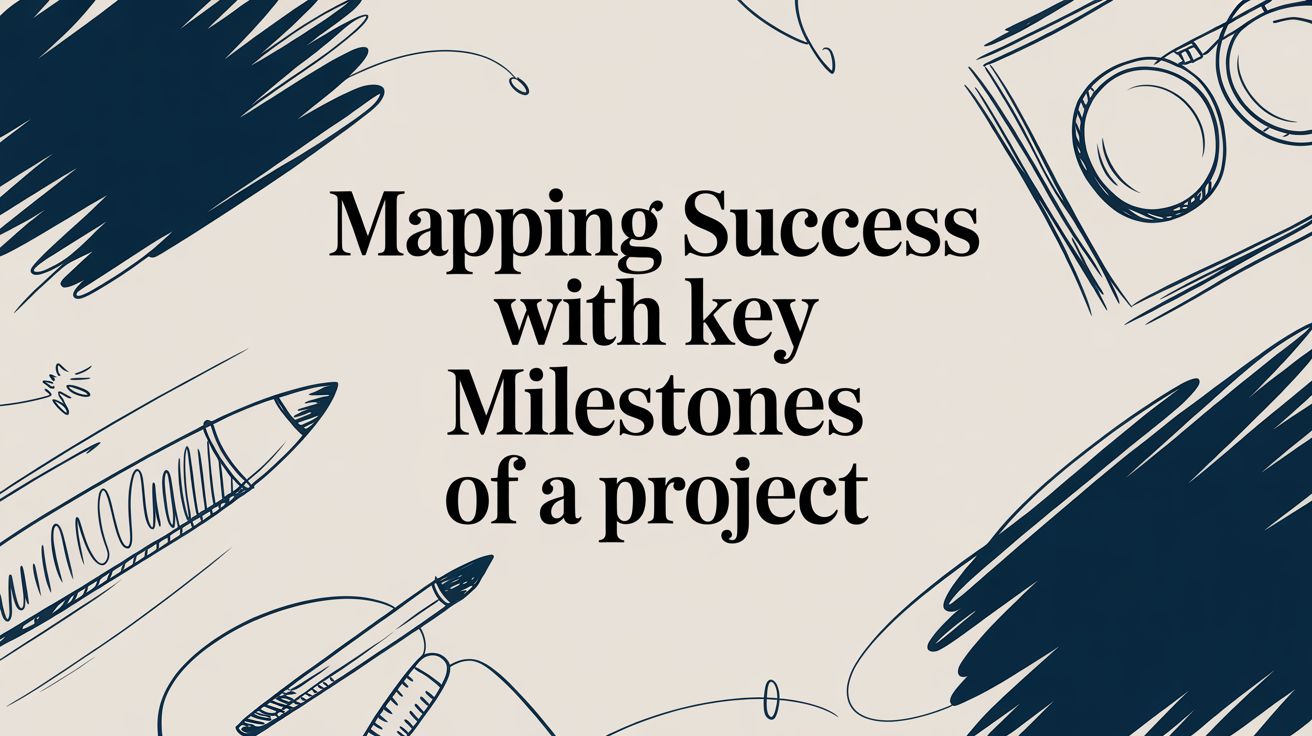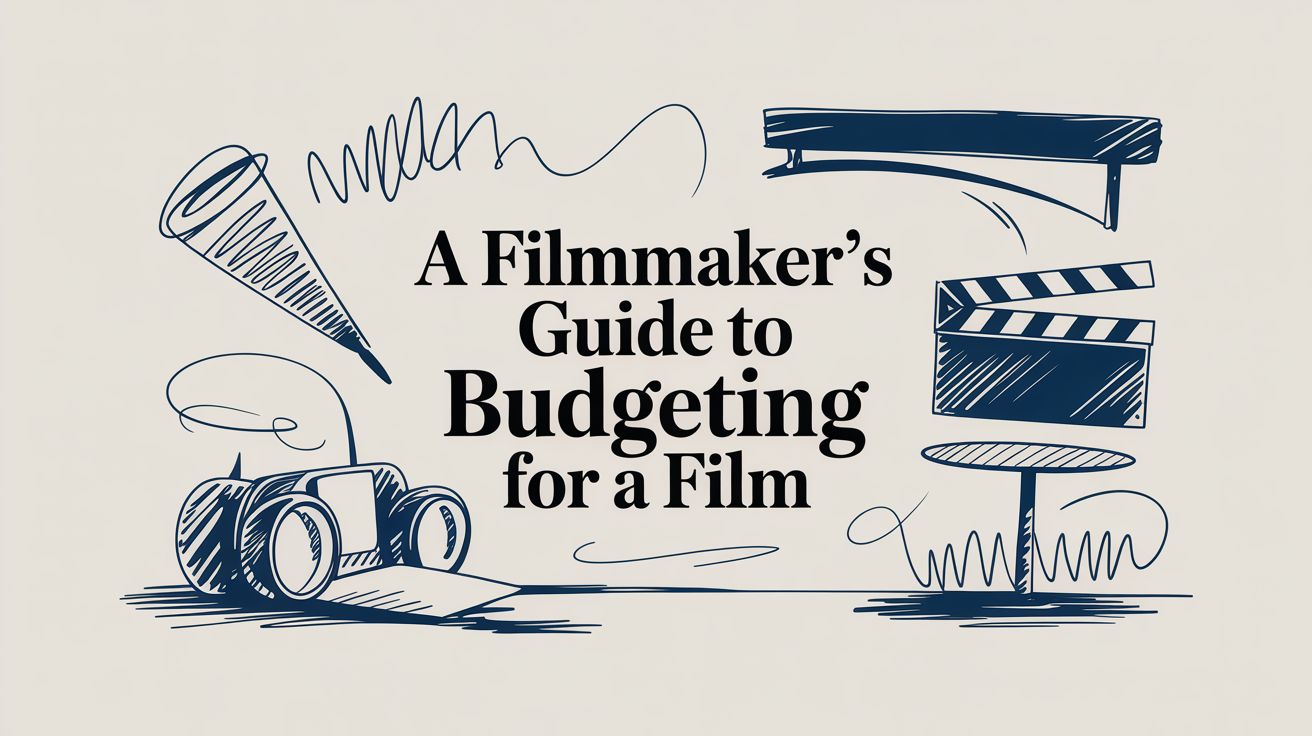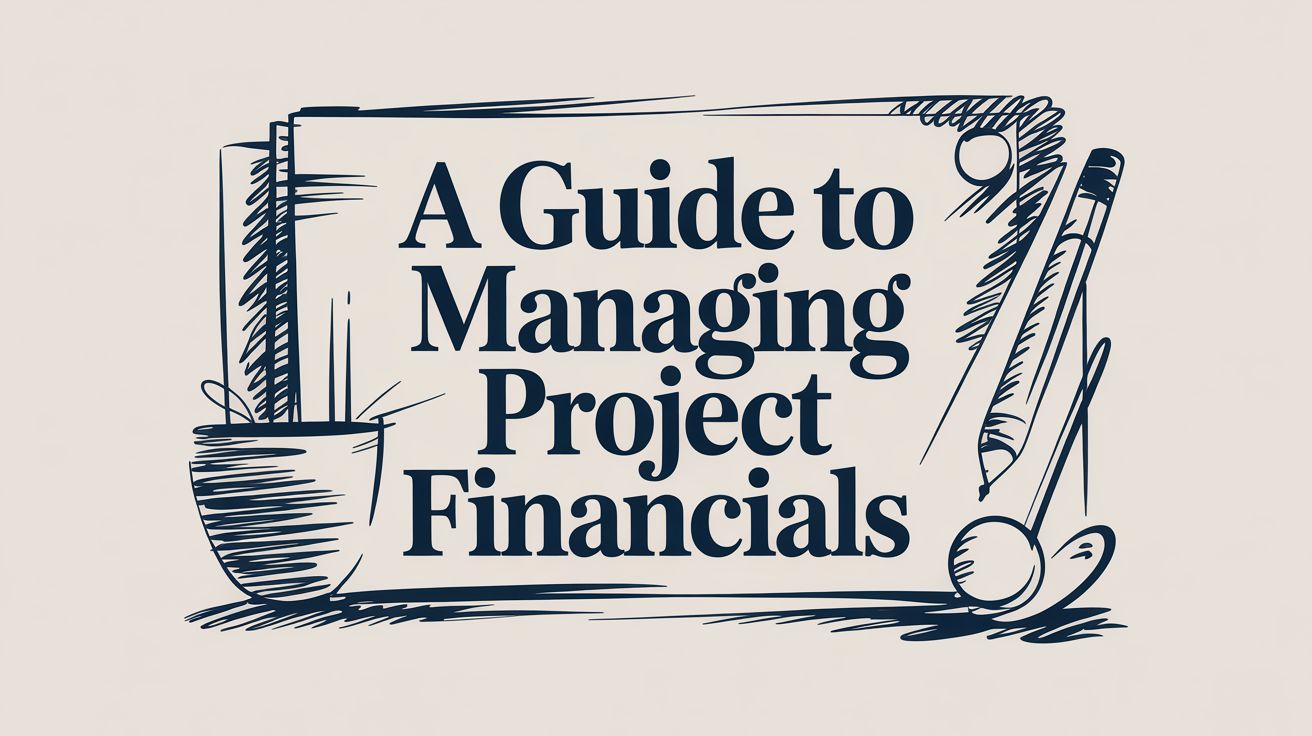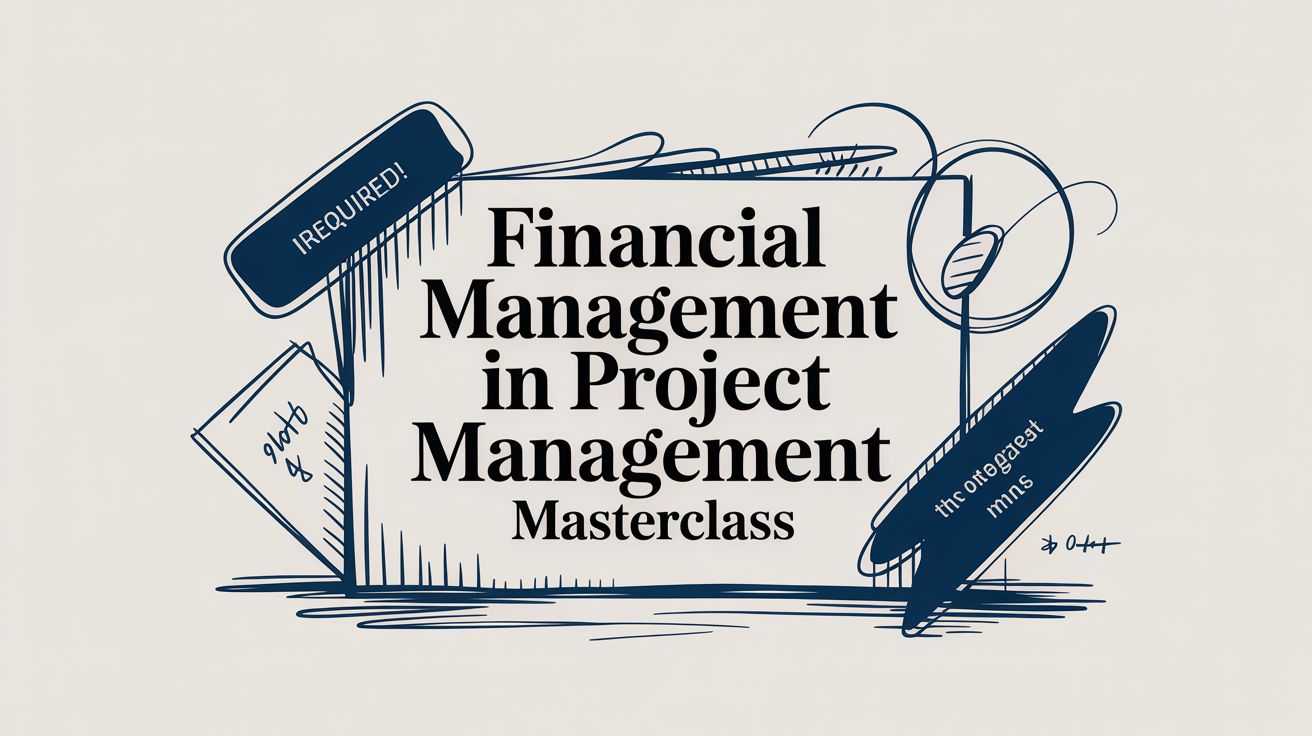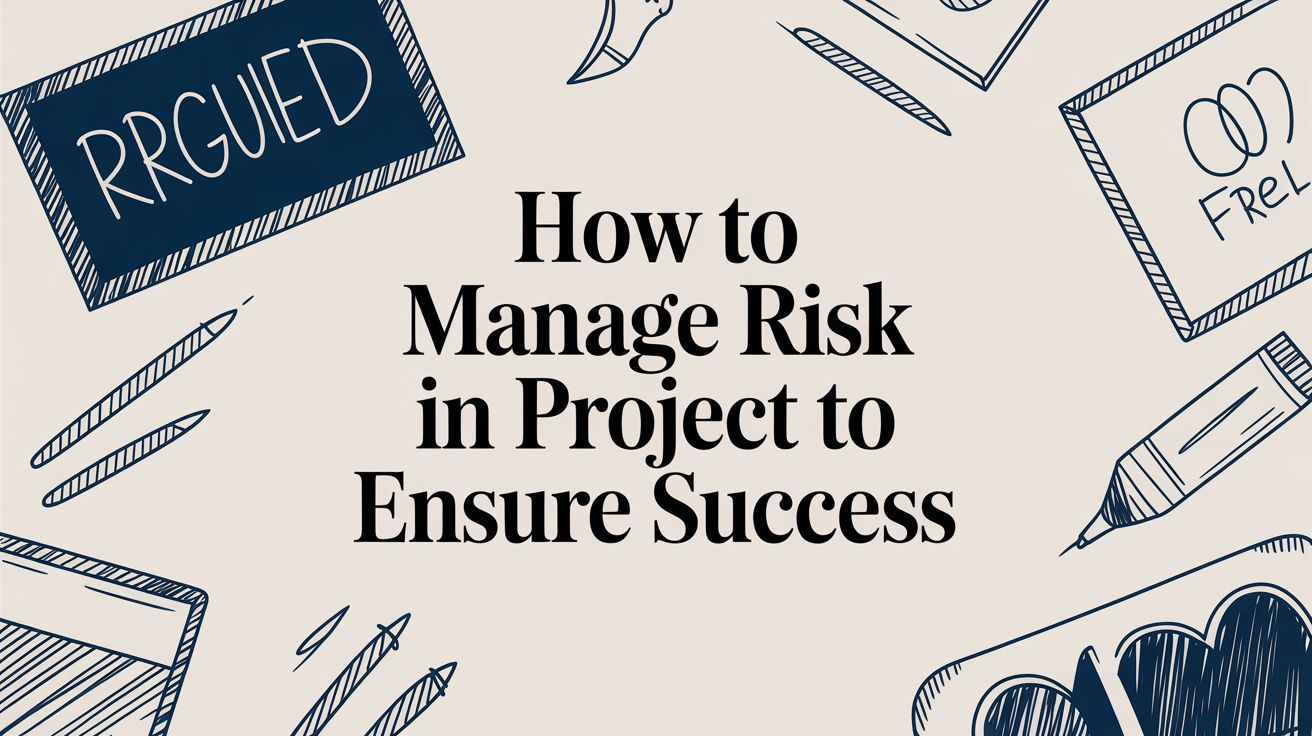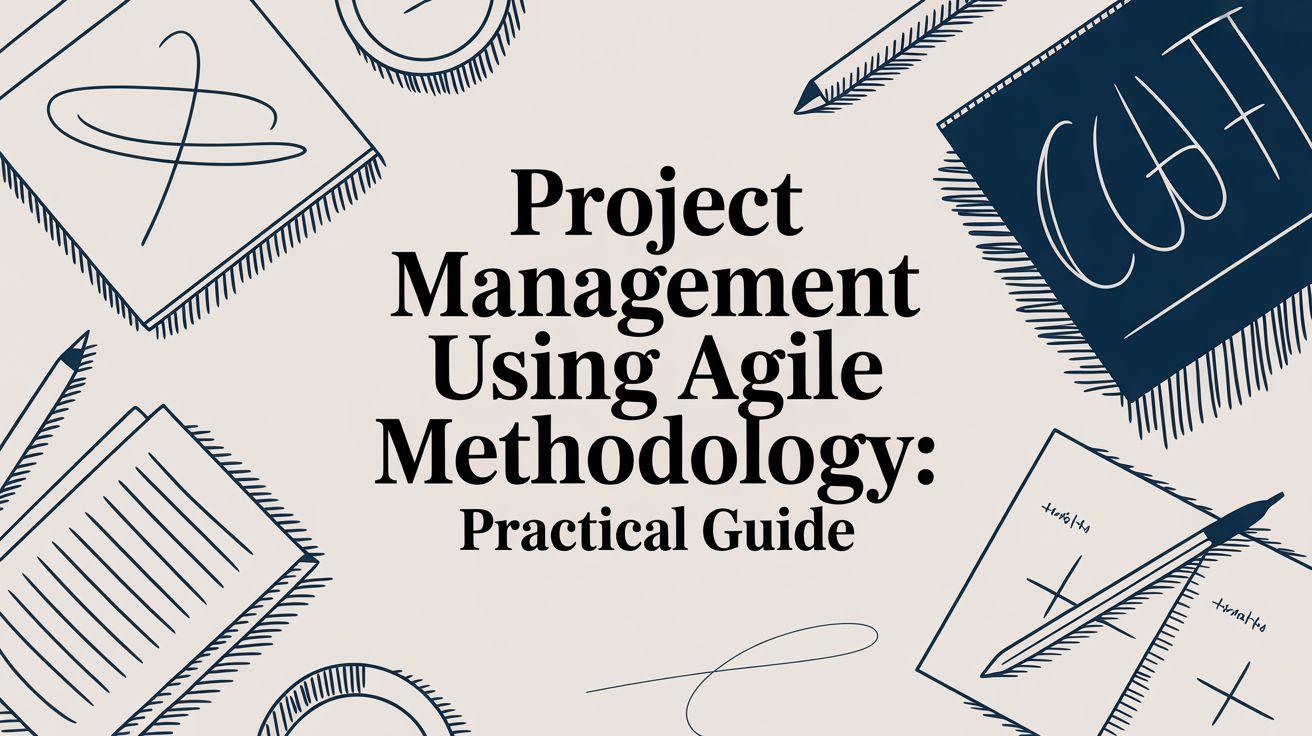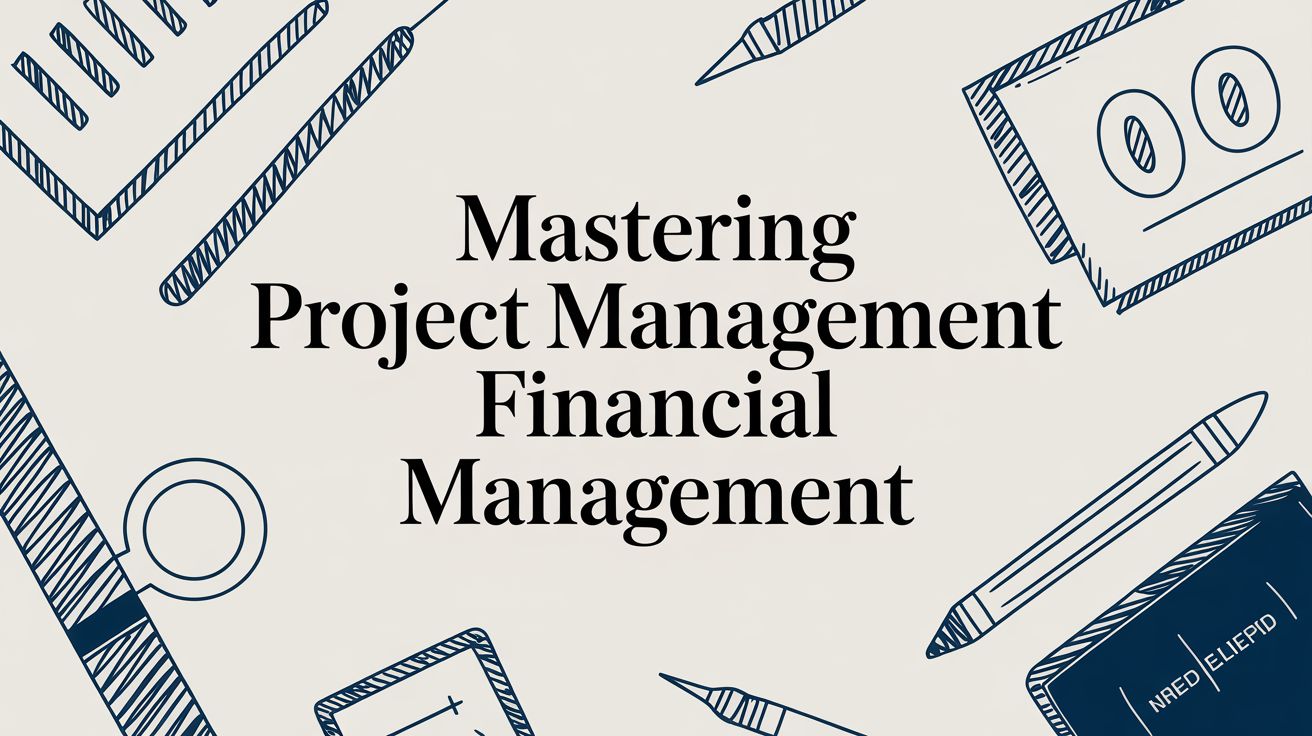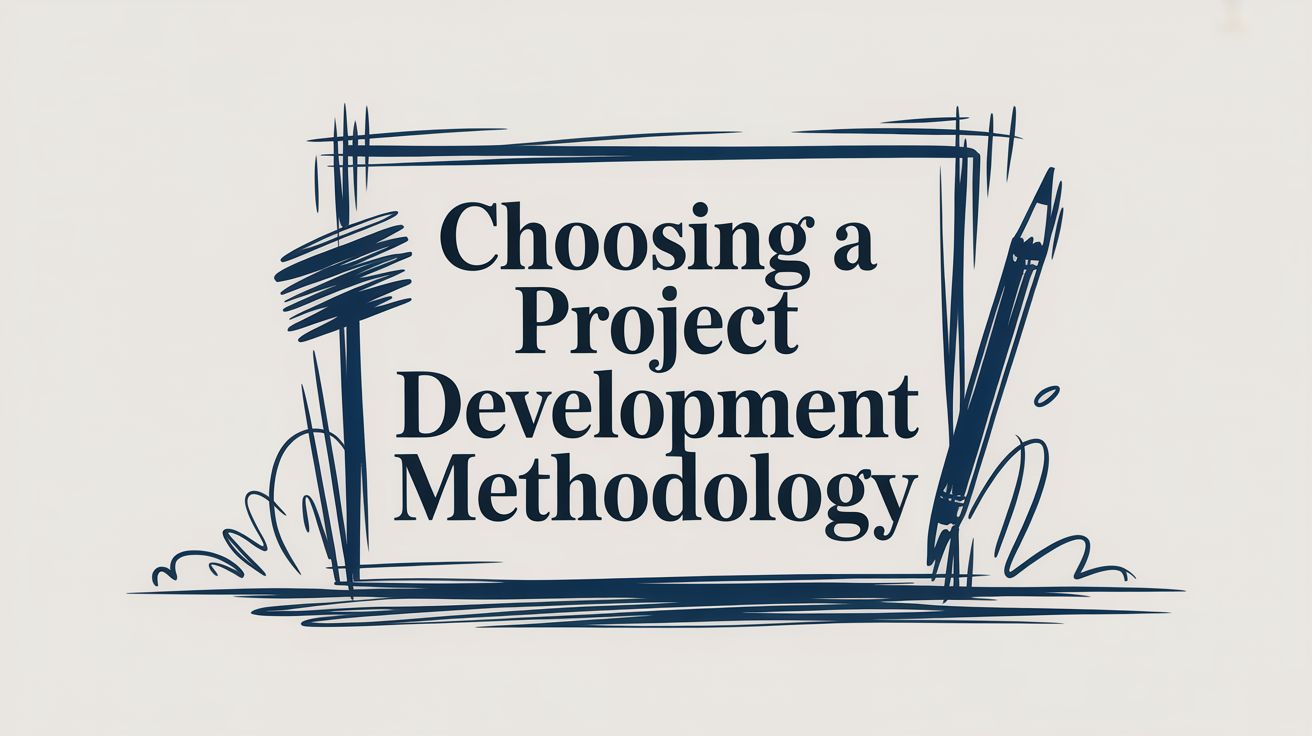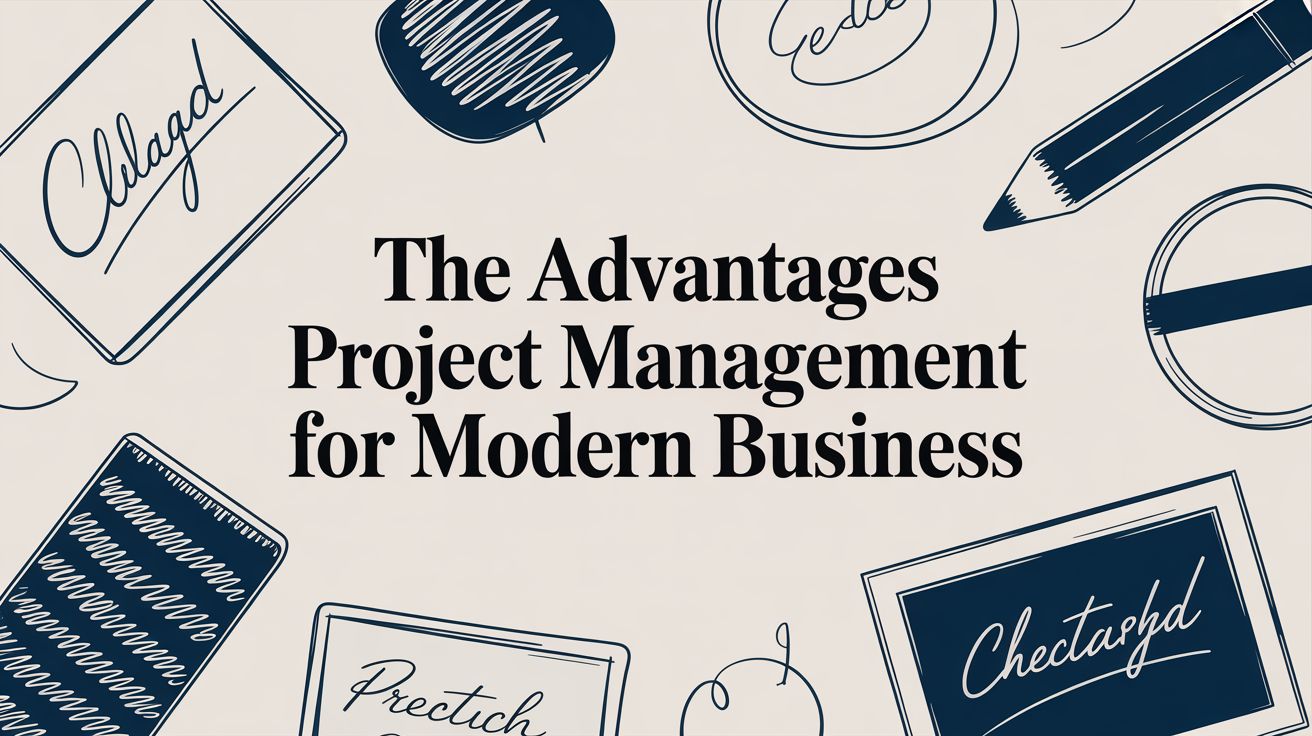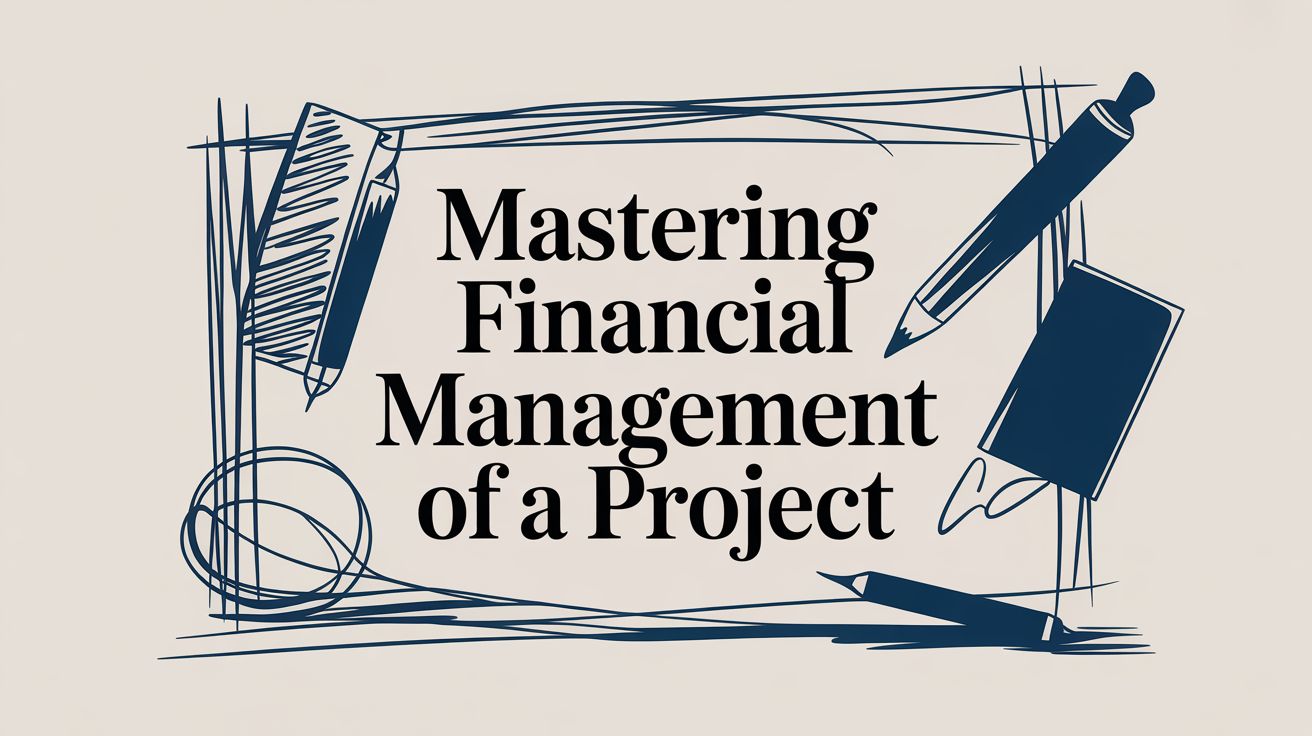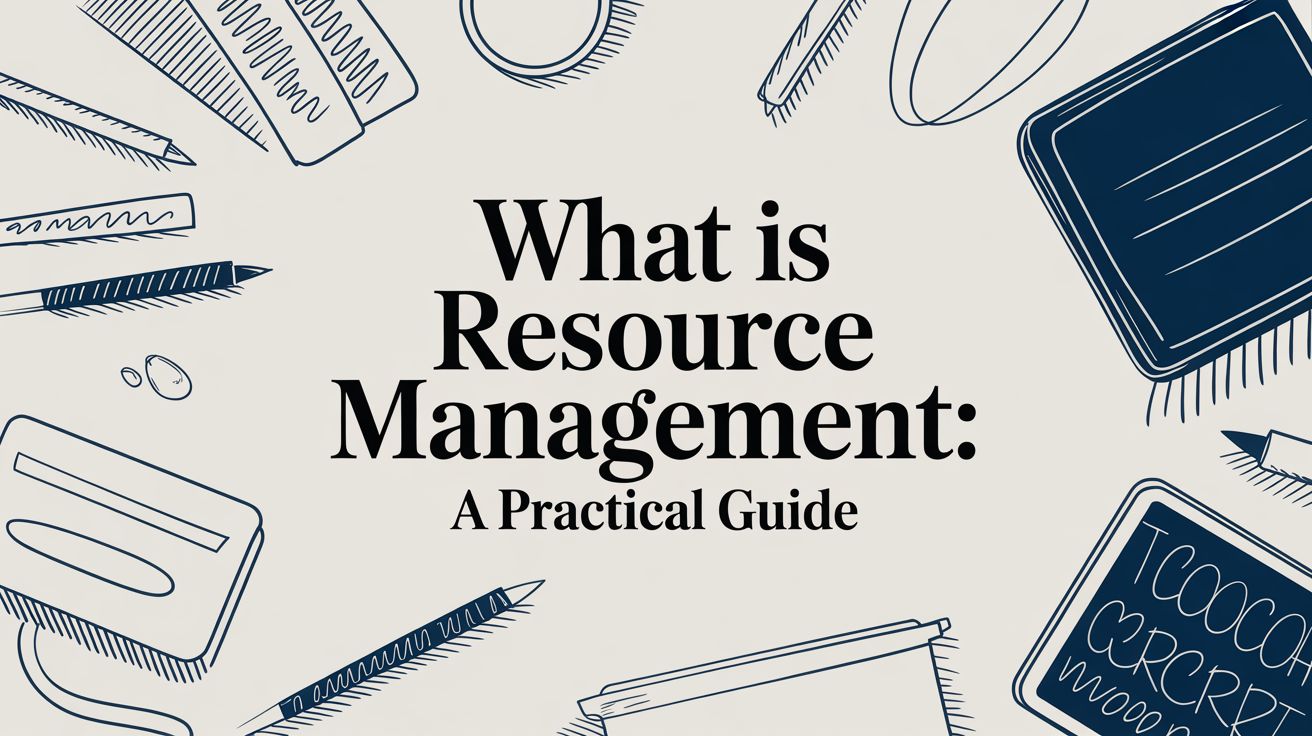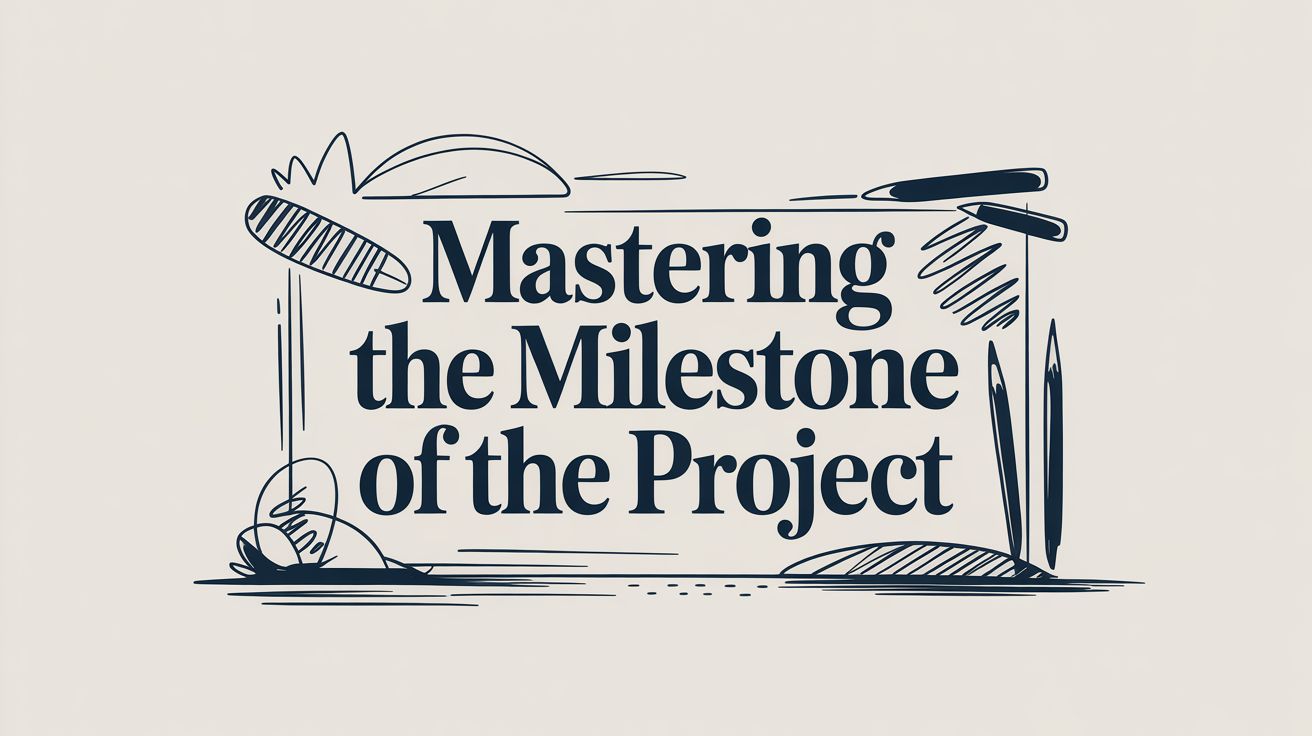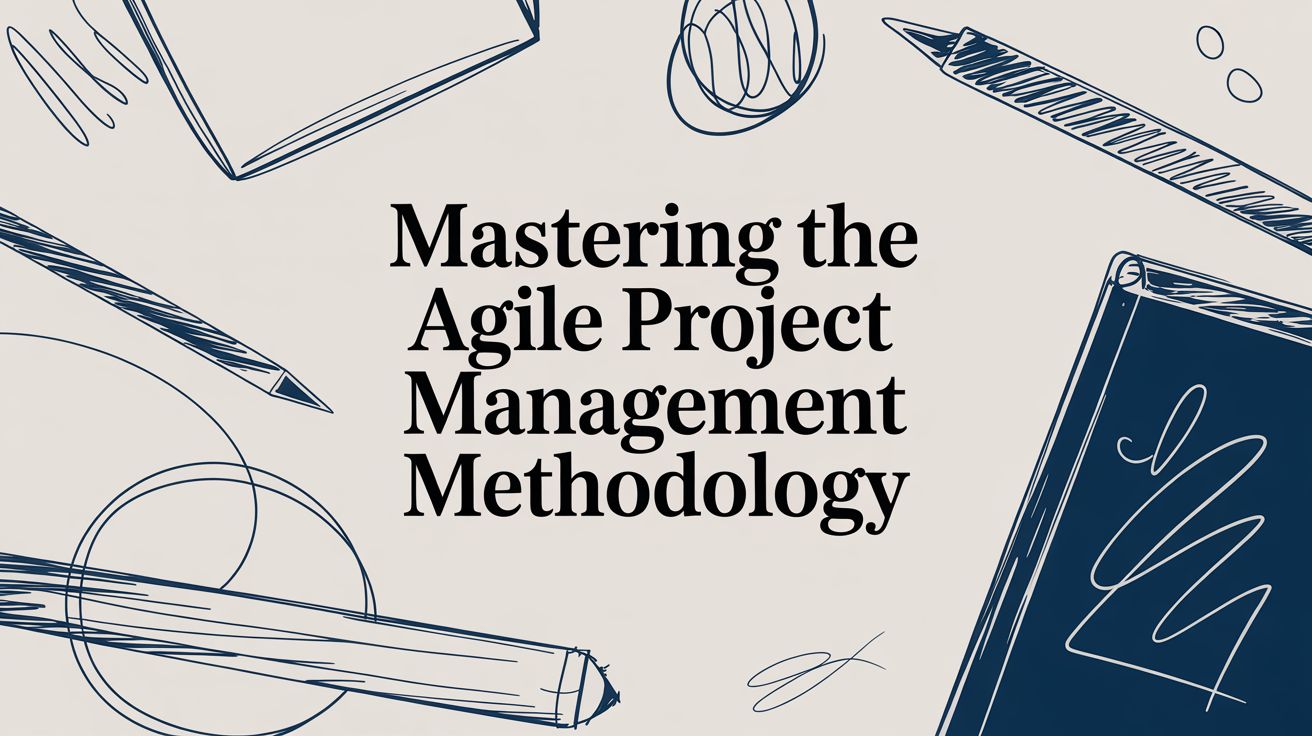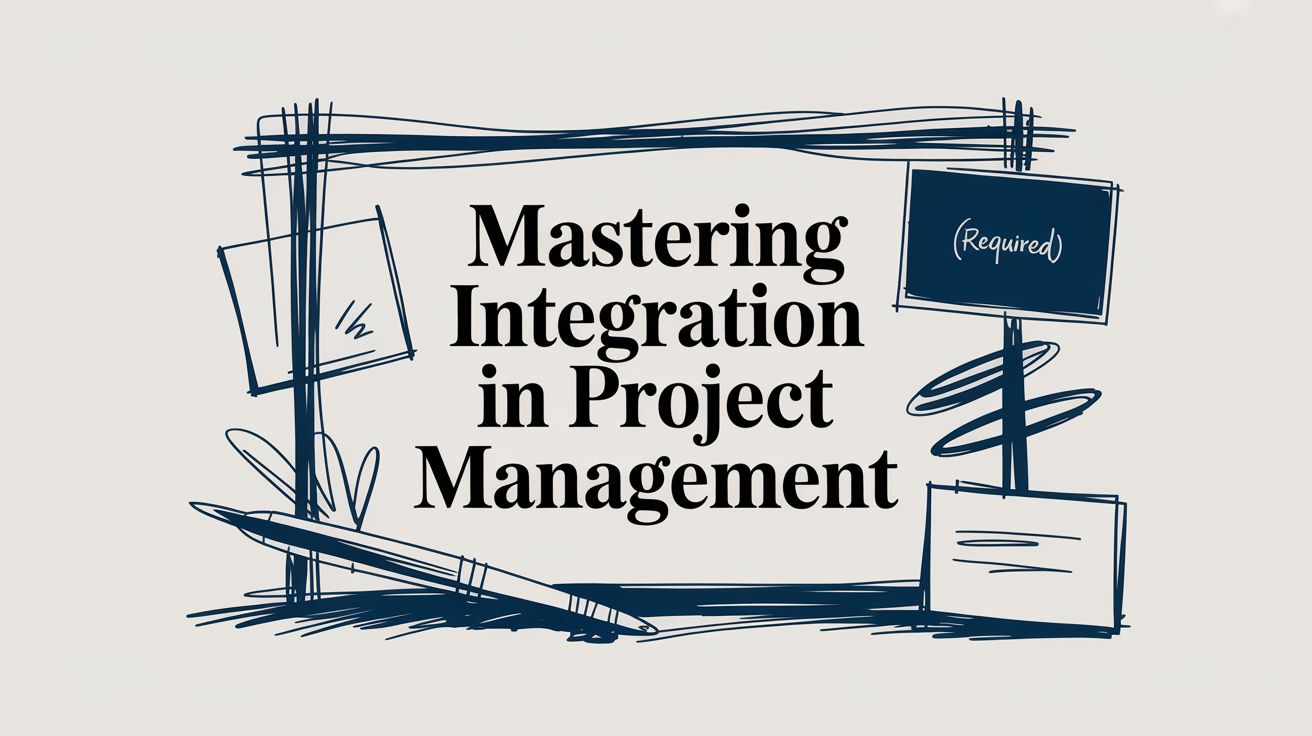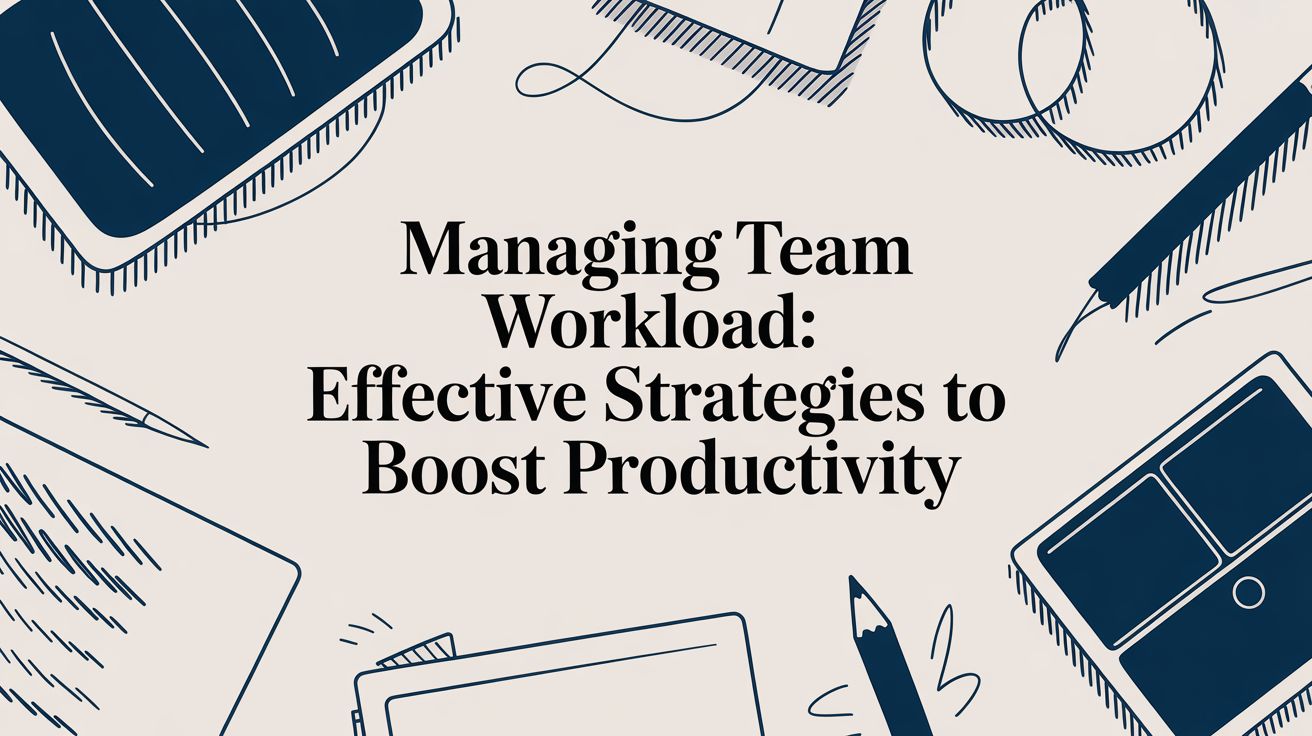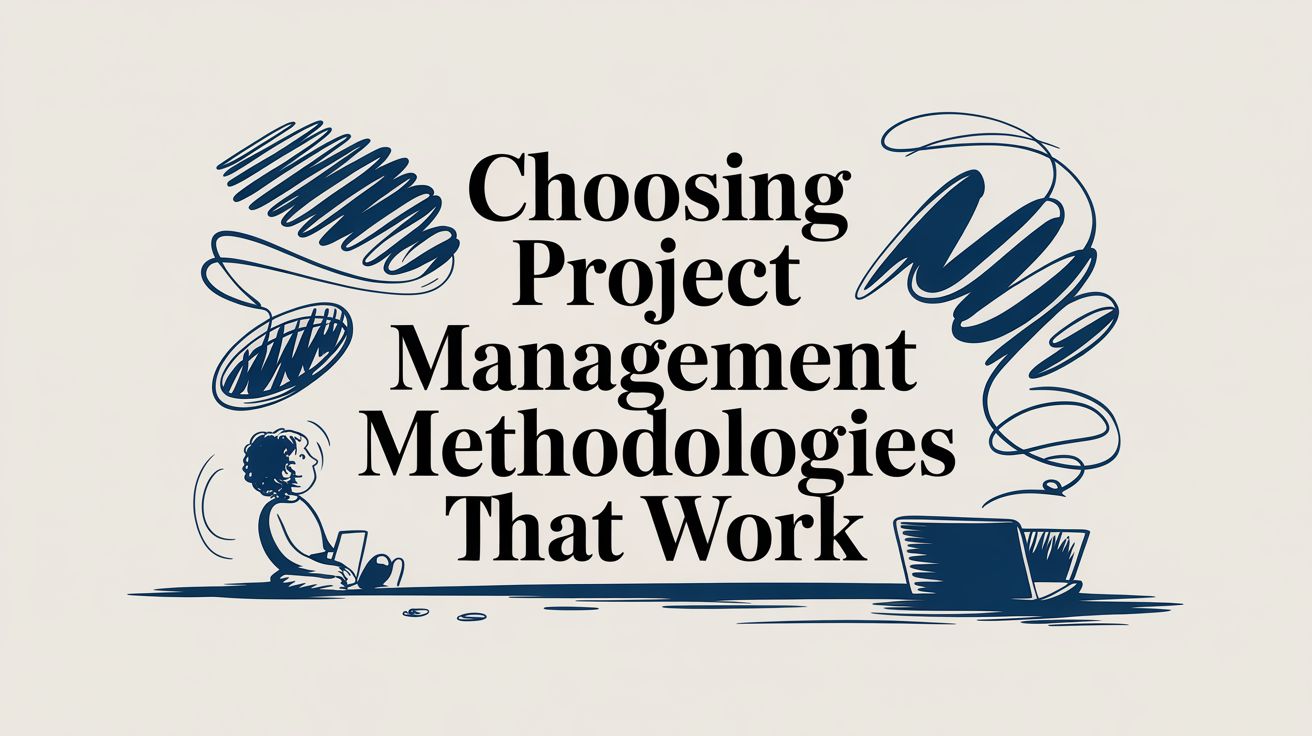Ever tried building a custom home without a blueprint? It sounds chaotic, right? No budget, no clear vision, just... hope. The five fundamental stages of project management are that essential blueprint, giving structure and a predictable journey from a simple idea to a finished, successful project.
Your Project's Journey From Idea to Reality
Every great project, whether it's launching a new app or building a skyscraper, follows a structured lifecycle. This isn't a mad dash to the finish line; it's more like a well-organised marathon, broken down into distinct phases. Each stage of project management builds on the last, turning a big-picture concept into something real you can see and touch.
Think of this lifecycle as the master plan for success. It ensures you have a solid foundation before you even think about laying the first brick. Getting a handle on this progression is what turns complex, messy undertakings into controlled, predictable, and ultimately successful outcomes. It's the roadmap that keeps everyone moving in the same direction.
Of course, a map is only useful if you know how to read it. That's where core project management best practices come in, helping you navigate each phase with confidence.
The Core Phases of a Project
The project management lifecycle isn't just theory from a textbook; it's a hands-on framework that guides every action and decision. These phases act as checkpoints, making sure the project stays true to its goals, on time, and within budget.
The infographic below shows how success is built step-by-step, starting with a clear purpose and ending with a final review.
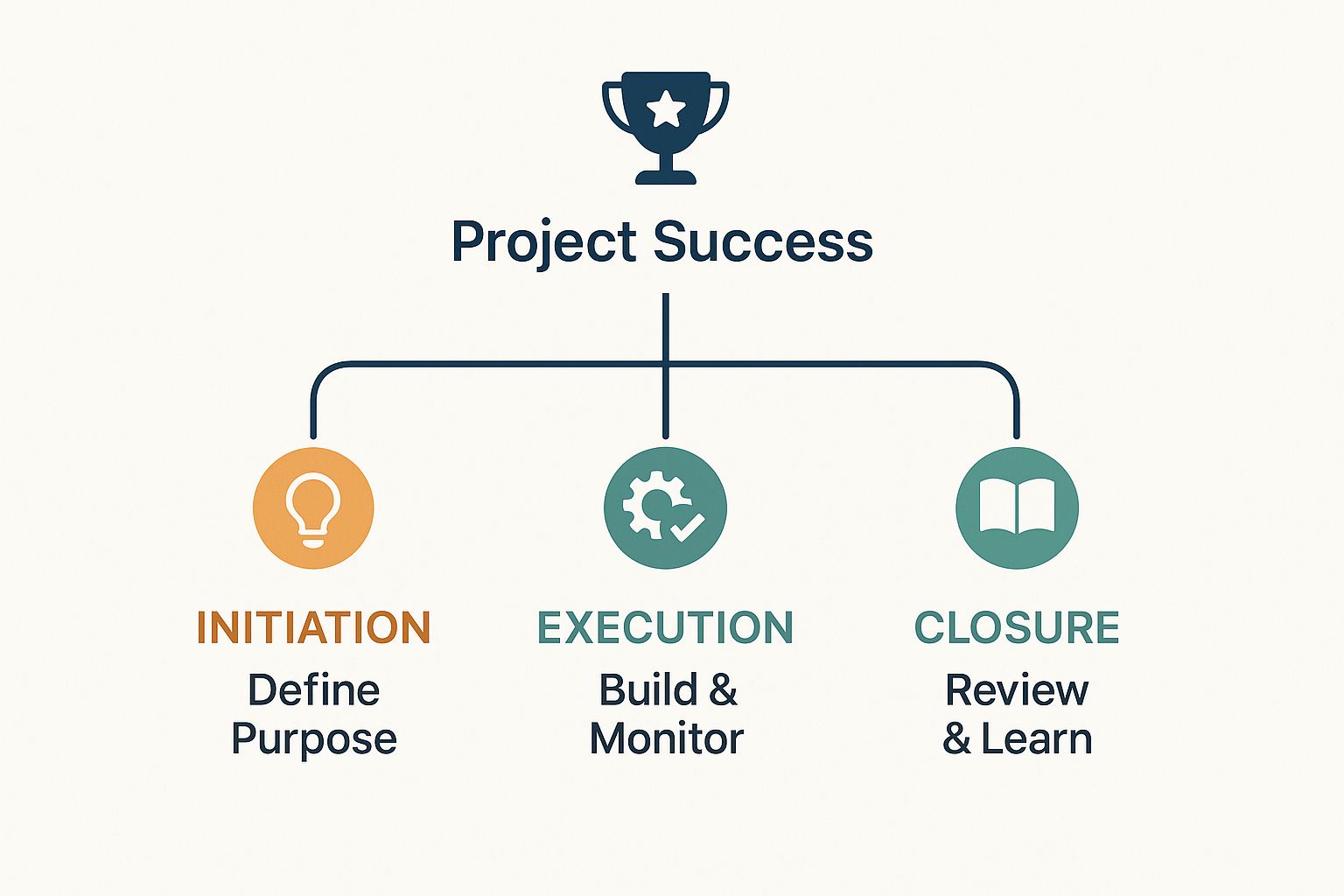
It’s a great visual reminder that success isn’t a one-off event. It's the result of moving methodically from initiation right through to execution and closure.
To give you a quick overview, here's a simple breakdown of what each stage is all about.
The 5 Stages of Project Management at a Glance
| Stage | Primary Goal | Key Deliverable |
|---|---|---|
| 1. Initiation | Define the project at a high level and secure approval. | A Project Charter or Business Case. |
| 2. Planning | Create a detailed roadmap to guide the team. | A comprehensive Project Plan. |
| 3. Execution | Put the plan into action and complete the work. | The actual project deliverables. |
| 4. Monitoring | Track progress and performance against the plan. | Status reports and performance data. |
| 5. Closure | Formally complete the project and hand off deliverables. | Final project report and lessons learned. |
Each step is a critical part of the whole, ensuring nothing falls through the cracks.
Why This Structure Matters
Let's be honest, without a structured approach, projects can easily fall into common traps that lead to failure. A defined lifecycle helps you sidestep these risks by bringing a bit of discipline and foresight to the table.
- Prevents Scope Creep: With defined goals for each stage, it’s much harder for unapproved changes to sneak in and derail the project.
- Improves Stakeholder Alignment: Formal stages with clear sign-offs mean everyone—from your team to your key investors—is on the same page.
- Enhances Resource Management: A phased approach makes it much easier to plan and allocate your people, budget, and tools effectively. For instance, freispace helps studios meticulously plan resources from the initial concept right through to final delivery.
By breaking down a large, intimidating goal into manageable stages, teams can maintain momentum and focus. This structured progression turns an abstract vision into an achievable plan, which is the cornerstone of effective project management.
At the end of the day, mastering each stage of project management is about creating a predictable path to success. It’s the difference between hoping for a good outcome and engineering one. Each phase gives you a chance to check in, adapt, and make sure the project is still on track to hit its goals.
Stage 1: Initiation – Defining Your Project's Purpose

Think of it as the first sketch an architect makes before touching the detailed blueprints. This phase isn’t about the nitty-gritty of every task. It's about asking the big, fundamental questions: What problem are we actually trying to solve? Is this idea worth our team's time and money? What does "done" even look like?
The main goal here is to figure out if the project is viable and has genuine merit. It’s all about getting the key players on board before you start throwing serious resources at it. Skip this, and you risk the project drifting aimlessly, burning through time and budget with no clear direction.
Turning a Vague Idea into a Concrete Proposal
The Initiation phase is where you take a high-level concept and shape it into a tangible proposal. You're building the business case, proving the project’s worth and showing how it lines up with the company's bigger goals. The aim is to gather just enough information to make a smart go/no-go decision.
This involves a few key moves:
- Running a Feasibility Study: This is a reality check from all angles. Can we technically do this? Do we have the people and equipment? Is it financially sound? Are there any legal hoops to jump through?
- Identifying Key Stakeholders: You need to know who’s involved from day one. This means everyone from the project sponsor and the end-users to the team members and any external partners.
- Defining the Initial Scope: You aren't listing every single feature yet, but you are drawing the basic boundaries. This is crucial for stopping the project from turning into a never-ending wish list later on.
Getting this groundwork right is everything. One study pointed out that a staggering 39% of projects fail because of poor planning, a problem that usually starts right here with a weak initiation. Nail this first step, and you massively stack the odds in your favour.
The Cornerstone Deliverable: The Project Charter
The main output of the Initiation stage is the project charter. This document isn’t just a piece of paper; it’s the project’s official birth certificate. It gives a high-level summary and, most importantly, grants the authority to actually begin.
The project charter is the North Star for the entire project. It summarises the purpose, objectives, and key stakeholders, acting as a constant reference point to make sure every decision stays true to the original vision.
Think of it as a formal handshake between the project team and the stakeholders. A solid charter will typically include:
- Project Vision and Objectives: A clear, simple statement of what you’re trying to achieve.
- High-Level Scope and Deliverables: What’s in, and just as critically, what’s out.
- Key Stakeholders and Roles: Who is backing the project and who is responsible for what.
- Initial Risks and Constraints: A first look at potential roadblocks and limitations.
- Budget Overview and Timeline: A rough estimate of the cost and major milestones.
For a post-production studio, this could be the moment they assess a new film. The charter would define the scope (e.g., colour grading and VFX), name the director and producers as key stakeholders, and lay out the initial budget and deadline. Using a tool like freispace at this early stage of project management helps studio managers instantly check if they have the right people and rooms available. This provides hard data to back up the project charter, ensuring the project is grounded in reality from the get-go.
Stage 2 Planning: Crafting Your Blueprint for Success

If initiation was the architect's rough sketch, this is where you create the detailed, floor-by-floor blueprint. Everyone, from the builders to the electricians, will rely on this document. It's the meticulous process of turning that high-level vision into a concrete, actionable roadmap.
This phase is all about defining the "how." How will we hit our goals? How long will it take? What will it cost? Answering these questions with precision is non-negotiable. It clears up ambiguity and gets the entire team moving in the same direction.
Deconstructing the Vision into Actionable Steps
First things first: you need to break down the project's big, lofty goals into smaller, manageable pieces. This is where you trade abstract ideas for tangible tasks, ensuring nothing gets missed and giving the project a clear structure.
The core tool for this job is the Work Breakdown Structure (WBS). Think of it as the table of contents for your project. You start with the main deliverable at the very top and then slice it down, layer by layer, into smaller work packages and individual tasks.
Imagine a post-production studio working on a feature film. Their WBS might look something like this:
- Main Deliverable: Final Film Master
- Work Package 1: Visual Effects (VFX)
- Task 1.1: Rotoscope key scenes
- Task 1.2: Composite green screen shots
- Task 1.3: Render final VFX sequences
- Work Package 2: Sound Design
- Task 2.1: Dialogue editing and cleanup
- Task 2.2: Foley and sound effects creation
- Task 2.3: Final audio mix and mastering
- Work Package 1: Visual Effects (VFX)
This granular view makes estimating time and resources far more accurate. It also gives every single team member a crystal-clear picture of their responsibilities.
Building a Realistic Timeline and Budget
With a detailed task list from your WBS, you can now start building the project schedule and budget. This isn't guesswork. It's a calculated process of estimating the time and cost for each task, then rolling those numbers up to create the master timeline and financial plan.
This is also when you'll set your milestones—those significant checkpoints that mark the completion of a major phase. Setting SMART (Specific, Measurable, Achievable, Relevant, Time-bound) goals is vital. Vague objectives like "improve the VFX" get replaced with concrete targets like "complete all VFX shots for Act 1 by 15 July." For more on this, check out our complete guide to project planning.
A project plan is more than just a schedule. It's the single source of truth for the entire project, outlining everything from scope and cost to communication protocols and risk management.
Smart resource management is the engine that drives this stage. In a busy studio, a manager needs to know instantly which colourists, sound engineers, or editing suites are free. This is where a tool like freispace becomes indispensable, offering a real-time overview of all your resources. You can allocate the right talent and equipment without creating bottlenecks or double-booking critical assets.
Preparing for the Unexpected with Risk Management
Let’s be honest: no project goes exactly as planned. The planning stage is your chance to get ahead of potential problems before they derail you. This is risk management – identifying threats, figuring out how likely they are to happen, and deciding how you’ll respond if they do.
A risk could be anything from a key team member getting sick to a software bug holding up a critical task. For each risk you identify, you need a mitigation strategy. This might mean building buffer time into the schedule, having backup equipment ready, or cross-training team members on essential skills.
This is especially true in industries with tight deadlines and complex moving parts, like construction. The demand for skilled leaders is high, with the number of construction project managers in the UK expected to hit around 90,800 in late 2024. For these pros, planning for risks like material delays or bad weather isn't an afterthought; it's a fundamental part of the job.
By putting in the hard work during the planning phase, you create a robust blueprint that not only guides your team but also equips them to handle the inevitable bumps in the road.
Stage 3 Execution: Bringing Your Plan to Life

After all the meticulous prep work, this is where the project finally springs to life. The blueprints are finished, the team is ready, and now it’s time to actually build the thing. The execution stage is all about turning that detailed plan into real, tangible progress as everyone rolls up their sleeves and gets to work.
This is almost always the most active and longest stage of project management. A project manager's role completely flips here. They go from being the plan's architect to the conductor of an orchestra, making sure every single person plays their part at exactly the right time and in perfect harmony.
It’s a dynamic time, packed with daily activity, creative problem-solving, and non-stop communication. The whole point is to produce the actual deliverables you outlined in the project plan—whether that’s coding a new app feature, editing a film sequence, or pouring a building's foundation.
Orchestrating the Team and Tasks
The heart of the execution phase is simply managing the day-to-day workflow. It's the project manager’s job to assign out the work, coordinate activities between different people or departments, and make sure everyone has what they need to get their part done.
This is where crystal-clear communication becomes non-negotiable. Regular meetings, status updates, and progress reports aren’t just box-ticking exercises; they're the project's lifeblood. They keep stakeholders in the loop, get the team on the same page, and help you spot potential problems before they escalate.
Solid task management is the key to it all. For creative teams juggling hundreds of individual tasks—from VFX rendering to sound mixing—you need a rock-solid system. It's worth exploring different approaches to task management to find what keeps complex projects flowing without a hitch.
Key Activities During Execution
While the specific to-do list will vary wildly from project to project, a few core activities are pretty much universal during this stage. These are the things that ensure the work actually follows the plan and meets the standards you set.
- Directing and Managing Project Work: This is the hands-on leadership—guiding the team, facilitating discussions, and making the daily calls that keep the project moving forward.
- Conducting Procurements: If you need outside vendors or resources, this is when you’ll be managing those contracts and relationships.
- Implementing the Risk Response Plan: When a risk you flagged during planning actually happens, you pull the trigger on your pre-planned response.
- Managing Stakeholder Engagement: This is a continuous effort. Keeping stakeholders updated and managing their expectations prevents nasty surprises and maintains their support.
Picture a post-production studio manager using freispace. During execution, they aren't just ticking off tasks. They're actively watching resource utilisation. If a colourist gets unexpectedly held up, the manager sees it in real-time and can instantly reassign another artist to a different critical task, stopping a bottleneck before it even forms.
"Execution is where the 'rubber meets the road.' It's the phase that consumes the most time and resources, and strong leadership is essential to navigate the inevitable challenges and keep the team motivated and focused on the end goal."
This just goes to show that while planning is vital, a project’s success ultimately comes down to how well that plan is carried out.
Navigating Challenges and Keeping Up Momentum
Let’s be honest: no project runs perfectly. The execution phase is usually where all the unforeseen issues decide to pop up. A key piece of equipment might break, a team member could quit, or a client might suddenly request a big change. A project manager's ability to adapt and think on their feet is tested daily.
Keeping team morale high is another huge piece of the puzzle. Long projects can be a real grind. Celebrating small wins and hitting key milestones is crucial for keeping everyone engaged and fired up. Great leadership here ensures that even when you hit a setback, the team stays focused and united, pushing the project towards a successful finish. This stage truly tests the resilience of both the plan and the people behind it.
Stage 4: Monitoring – Keeping the Project on Course
If the execution phase is about setting sail, the monitoring and control stage is about being the vigilant captain on the bridge. This phase doesn't happen after execution; it runs right alongside it, acting as the project's real-time navigation system. It’s one thing to have a great map, but you constantly need to check your compass to make sure you're still heading true north.
Think of it this way: the initial plan is your charted course across the ocean. But what happens when unexpected currents push you slightly off track, or a storm brews on the horizon? A good captain doesn't just hold the wheel and hope for the best. They constantly monitor the ship's position, check the weather, and adjust the sails. That's exactly what this stage is all about—proactive oversight that stops a tiny drift from becoming a major navigational disaster.
Here, you're systematically tracking how things are actually going compared to how you thought they would go. Deviations are inevitable. A task will fall behind, costs might creep up, or a stakeholder will suddenly remember a "small" new requirement. This is the stage where you spot those issues early, figure out their impact, and take decisive action to get back on track.
Key Activities: Measuring What Matters
The heart of effective monitoring lies in tracking your Key Performance Indicators (KPIs). These aren't just random numbers to fill a report; they are the vital signs of your project, telling you if it's healthy or heading for trouble. It's a constant feedback loop: measure, compare, act, repeat.
Some of the most critical KPIs to keep a close eye on include:
- Schedule Variance: Are we ahead or behind? This simple check is your first warning if deadlines are in jeopardy.
- Cost Variance: How does our actual spending stack up against the budget? This helps you snuff out financial fires before they get out of control.
- Quality Metrics: Are the deliverables meeting the standards we agreed on? Tracking things like bug reports or client feedback ensures the end product is actually fit for purpose.
- Resource Utilisation: Is anyone on the team completely swamped while others are twiddling their thumbs? Optimising this is key to getting the most from your talented people without burning them out.
These metrics give you the hard data you need to make smart decisions instead of just going with your gut. For creative studios, this is a game-changer. A tool like freispace gives managers an instant, clear view of these metrics, showing exactly how actual time spent on tasks compares to the original estimates. To dive deeper into the financial side of things, check out our guide on budgeting and controlling.
From Monitoring to Controlling
Spotting a problem is only half the job. The "control" part of this stage is about what you do next. When a KPI flashes red, it’s the project manager’s cue to step in and find a solution.
Controlling isn’t about micromanaging every little detail. It’s about steering the project back on course. It means digging into the root cause of an issue and making a change to stop it from derailing the whole effort.
This could mean shuffling resources to a task that’s falling behind, tweaking the schedule to absorb a delay, or having a firm but fair chat with a stakeholder about scope creep. The aim is always to keep the project aligned with its core objectives while navigating the messy reality of getting things done.
It's a skill that's highly valued, and you can see its importance reflected in the industry. According to the APM Salary and Market Trends Survey 2025, average salaries for project managers in the UK have jumped by 10% to £52,500. This shows just how much demand there is for professionals who can masterfully handle the push and pull of monitoring and control. You can read more about these project management salary trends directly from the source.
Ultimately, this cycle of monitoring performance and applying controls is what separates a successful project from a cautionary tale. It builds in the discipline and agility needed to handle the curveballs that execution always throws, ensuring the final result meets expectations, on time and on budget.
Stage 5: Closure – Finalising the Project and Learning Lessons
Crossing the finish line is a fantastic feeling, but a project isn’t truly done just because the final deliverable is out the door. The Closure stage is the last, crucial step in the whole process, though it's often rushed in the excitement of wrapping things up. Think of it less as an administrative clean-up and more as a methodical process for formally ending all activities.
This final stage of project management is all about a clean, professional finish. It’s more than just saying "we're done." It involves a series of deliberate steps to tie up every loose end, whether it’s administrative, contractual, or operational.
Key Activities for a Clean Project Closeout
To wrap up a project properly, you need to tick a few key boxes. These steps give stakeholders formal closure and, just as importantly, capture priceless knowledge for the company.
- Securing Final Sign-Off: This is the official thumbs-up from the client or sponsor, confirming you've met every requirement. It formally passes ownership over to them.
- Releasing the Project Team: Once all the work is complete, your team members need to be formally released so they can jump onto new projects. This keeps resource conflicts at bay and makes for a smooth handover.
- Archiving Project Documents: Every bit of paperwork—from the first charter to the final reports—needs to be stored in one central place. This creates a historical record that can be an absolute lifesaver for future projects.
For a post-production studio, this is where a tool like freispace gives you that final, bird's-eye view. Managers can see that every task is marked complete, final invoices are generated from tracked time, and the project's financial performance is neatly documented, all in one spot.
The Power of the Post-Mortem
Maybe the single most valuable part of the Closure phase is the post-mortem, or lessons-learned session. It’s a structured sit-down where the entire team gets together to reflect on the project from start to finish.
A post-mortem isn't about pointing fingers; it's about institutional learning. It’s a frank chat to figure out what went well, what didn't, and why. The insights you get from this are pure gold, helping you refine your processes and avoid making the same mistakes twice.
And finally, don't forget to celebrate. Taking a moment to acknowledge the team's hard work and success is brilliant for morale. It formally marks the end of their collective effort and sets a positive tone for whatever comes next.
A Few Common Questions About Project Management Stages
To wrap things up, let's tackle a few questions that often come up when people are getting to grips with the project management lifecycle. Each stage of project management has its own job to do, but the real magic happens when you understand how they all flow together.
Which Stage Is The Most Important?
This is a classic question. While you can't succeed without giving every stage its due, most seasoned project managers will point to one in particular: the Planning stage is the most critical.
Think of it like building a house. A weak or rushed blueprint will doom the entire project before the first brick is even laid. A solid plan is your foundation. Without it, the execution phase descends into chaos, monitoring becomes a pointless box-ticking exercise, and the finished product will almost certainly miss the mark. Getting the plan right from the start saves an incredible amount of time, money, and headaches down the road.
How Does Agile Methodology Fit Into All This?
Agile doesn't throw the lifecycle out the window; it just rethinks it. Instead of one long, sequential journey through all the stages, Agile projects are broken down into short, repeatable cycles called sprints.
You can think of each sprint as its own mini-project, complete with a condensed lifecycle. There’s a planning phase, an execution phase where the work gets done, and a review (or closure) phase to look at what was accomplished and get feedback.
This iterative approach is what gives Agile its famous flexibility, allowing teams to adapt and change course as the project unfolds.
Can You Go Back To A Previous Stage?
Absolutely, and you often should. The project management lifecycle isn't always a one-way street. It’s perfectly normal—and sometimes essential—to revisit an earlier stage. If you're curious about how leadership roles influence these environments, understanding the difference between a Project Manager vs. Product Manager can be quite revealing.
For instance, the Monitoring stage is designed to uncover problems or changes in the project's environment. When that happens, you might need to jump back to the Planning stage to tweak the scope, update the schedule, or re-evaluate the budget. This isn't a sign of failure; it's a sign of a healthy, responsive project that stays aligned with its goals.
Ready to master every stage of your creative projects? freispace gives you the tools you need for effortless resource planning, task management, and budget control, from day one to final delivery. See how you can deliver exceptional results by visiting https://freispace.com today.

